Unit 5 Accounting Principles
VerifiedAdded on 2023/06/09
|20
|4730
|186
AI Summary
This report discusses the purpose of accounting for meeting the requirements of firms, society and stakeholders. It also analyzes the role of supporting new IT technology in accounting and decision making. The report measures the regulatory and ethical discipline of BAJ Shop and the role of accounting in informing decision making to achieve firms, stakeholder and societal requirements. It also includes the calculation of financial statements and ratios for BAJ Shop. Subject: Accounting, Course Code: ACC101, College/University: Not mentioned.
Contribute Materials
Your contribution can guide someone’s learning journey. Share your
documents today.
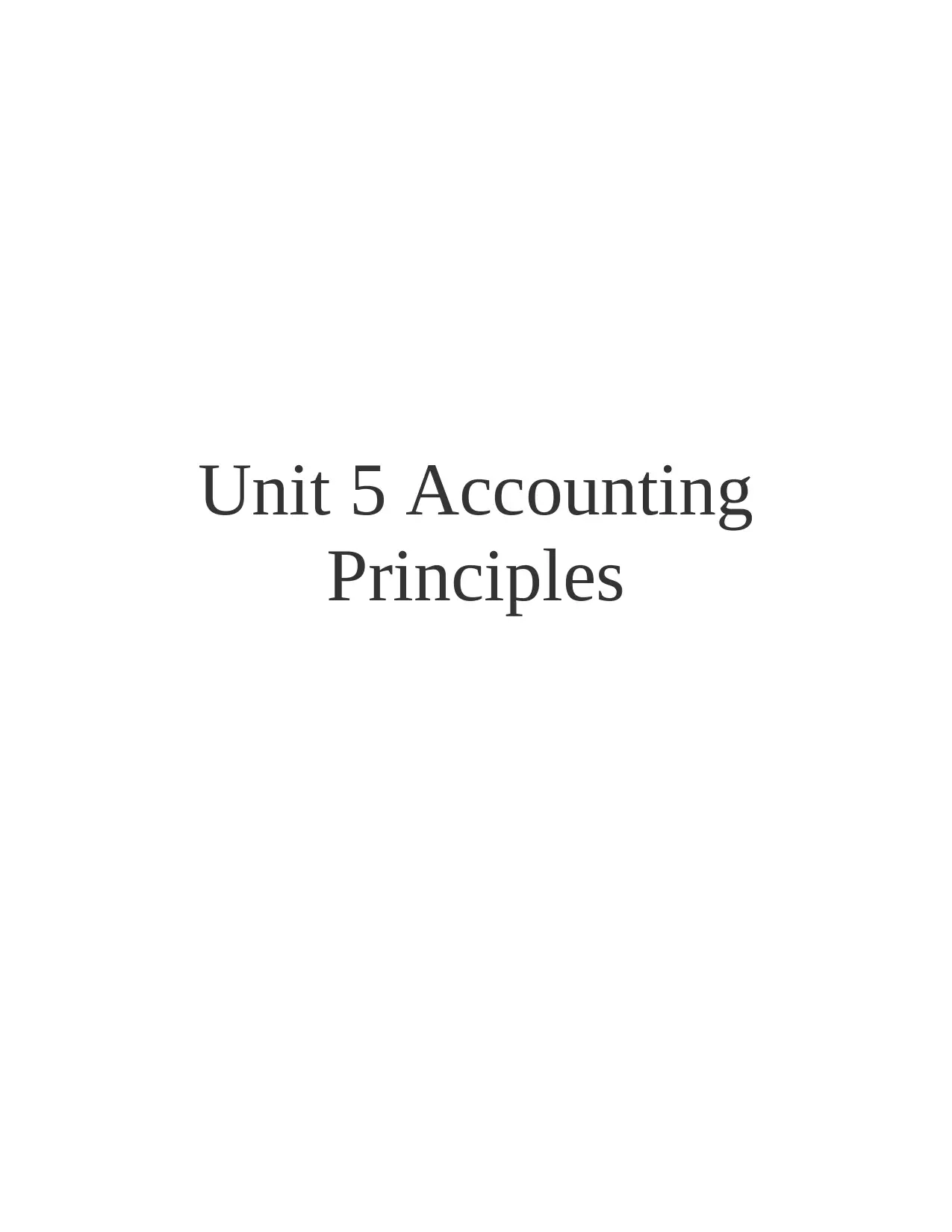
Unit 5 Accounting
Principles
Principles
Secure Best Marks with AI Grader
Need help grading? Try our AI Grader for instant feedback on your assignments.
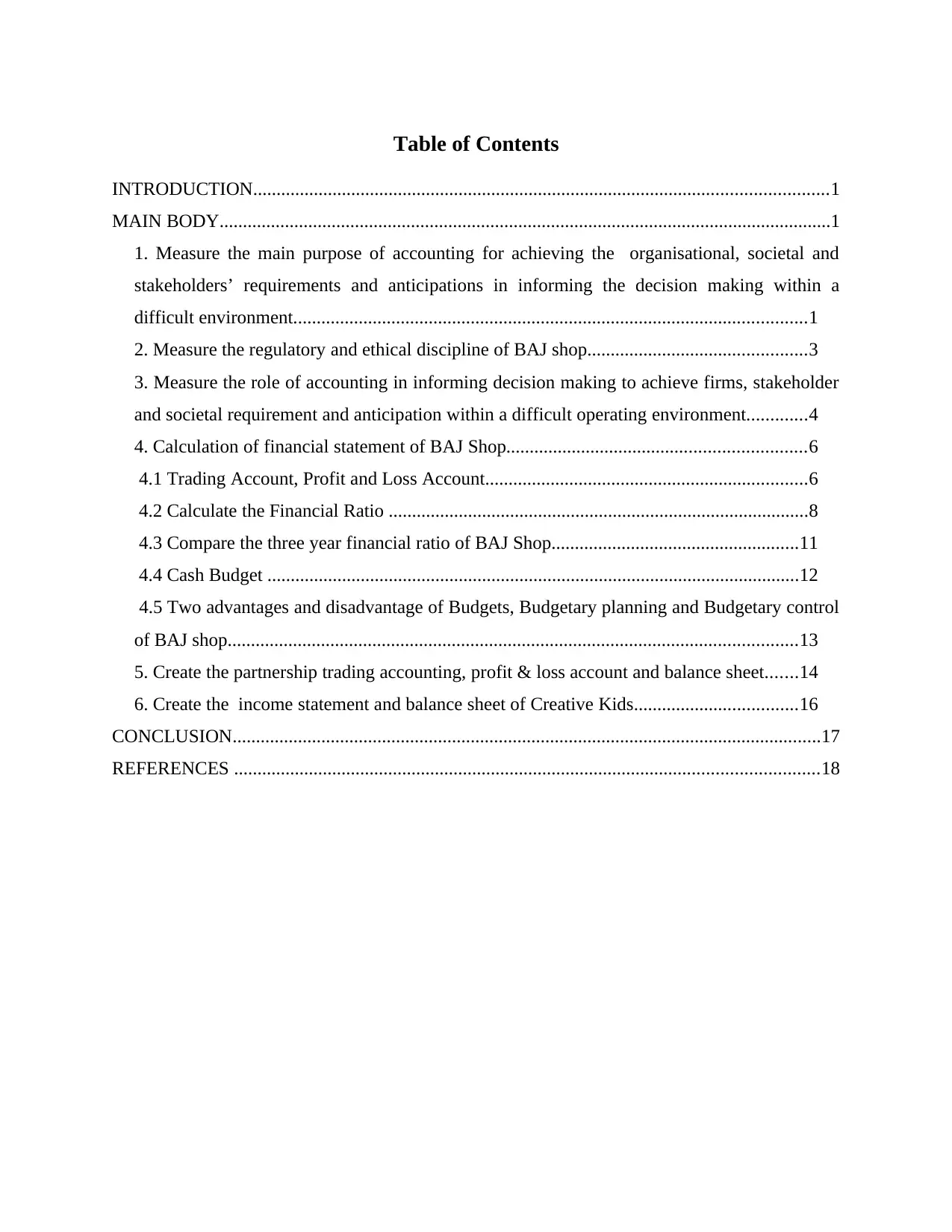
Table of Contents
INTRODUCTION...........................................................................................................................1
MAIN BODY...................................................................................................................................1
1. Measure the main purpose of accounting for achieving the organisational, societal and
stakeholders’ requirements and anticipations in informing the decision making within a
difficult environment..............................................................................................................1
2. Measure the regulatory and ethical discipline of BAJ shop...............................................3
3. Measure the role of accounting in informing decision making to achieve firms, stakeholder
and societal requirement and anticipation within a difficult operating environment.............4
4. Calculation of financial statement of BAJ Shop................................................................6
4.1 Trading Account, Profit and Loss Account.....................................................................6
4.2 Calculate the Financial Ratio ..........................................................................................8
4.3 Compare the three year financial ratio of BAJ Shop.....................................................11
4.4 Cash Budget ..................................................................................................................12
4.5 Two advantages and disadvantage of Budgets, Budgetary planning and Budgetary control
of BAJ shop..........................................................................................................................13
5. Create the partnership trading accounting, profit & loss account and balance sheet.......14
6. Create the income statement and balance sheet of Creative Kids...................................16
CONCLUSION..............................................................................................................................17
REFERENCES .............................................................................................................................18
INTRODUCTION...........................................................................................................................1
MAIN BODY...................................................................................................................................1
1. Measure the main purpose of accounting for achieving the organisational, societal and
stakeholders’ requirements and anticipations in informing the decision making within a
difficult environment..............................................................................................................1
2. Measure the regulatory and ethical discipline of BAJ shop...............................................3
3. Measure the role of accounting in informing decision making to achieve firms, stakeholder
and societal requirement and anticipation within a difficult operating environment.............4
4. Calculation of financial statement of BAJ Shop................................................................6
4.1 Trading Account, Profit and Loss Account.....................................................................6
4.2 Calculate the Financial Ratio ..........................................................................................8
4.3 Compare the three year financial ratio of BAJ Shop.....................................................11
4.4 Cash Budget ..................................................................................................................12
4.5 Two advantages and disadvantage of Budgets, Budgetary planning and Budgetary control
of BAJ shop..........................................................................................................................13
5. Create the partnership trading accounting, profit & loss account and balance sheet.......14
6. Create the income statement and balance sheet of Creative Kids...................................16
CONCLUSION..............................................................................................................................17
REFERENCES .............................................................................................................................18
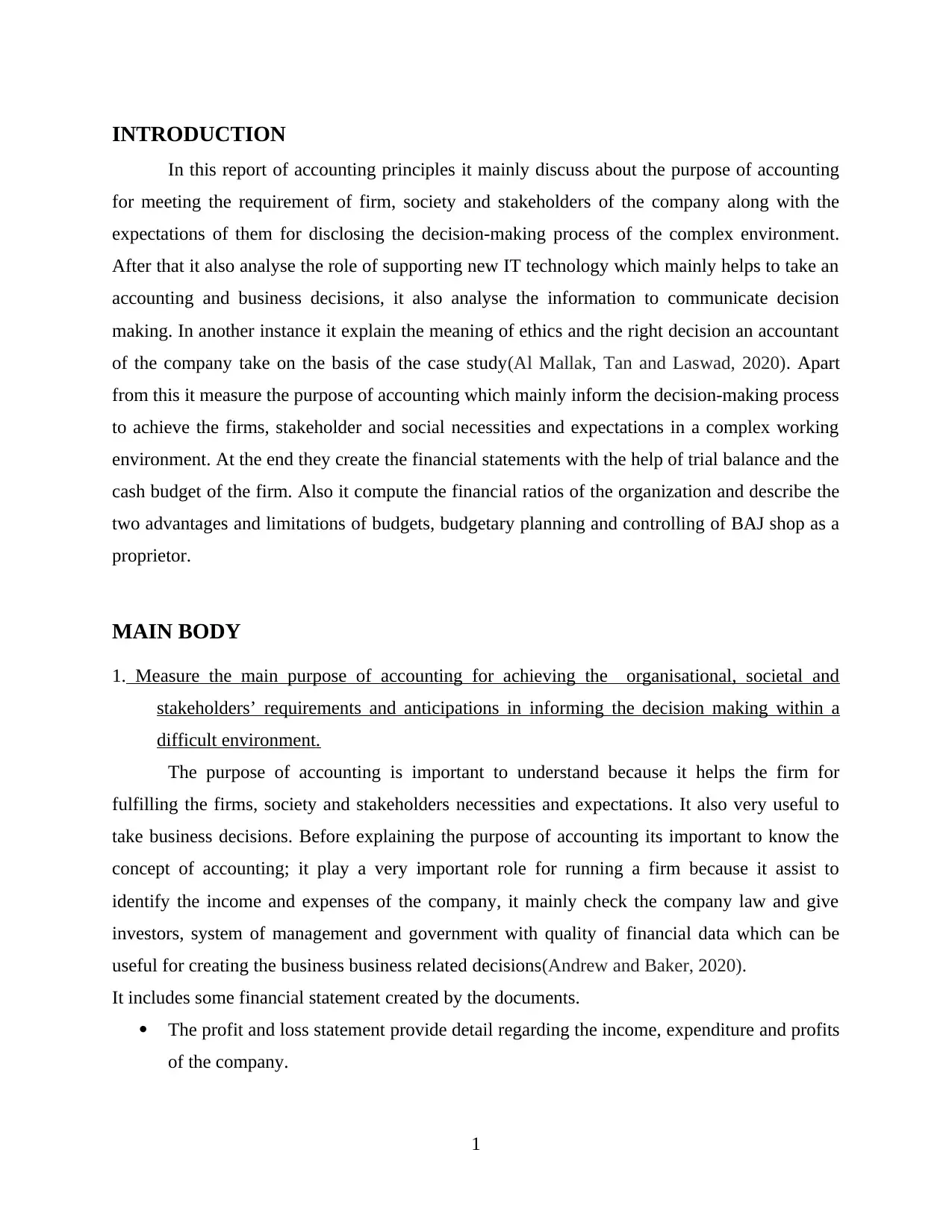
INTRODUCTION
In this report of accounting principles it mainly discuss about the purpose of accounting
for meeting the requirement of firm, society and stakeholders of the company along with the
expectations of them for disclosing the decision-making process of the complex environment.
After that it also analyse the role of supporting new IT technology which mainly helps to take an
accounting and business decisions, it also analyse the information to communicate decision
making. In another instance it explain the meaning of ethics and the right decision an accountant
of the company take on the basis of the case study(Al Mallak, Tan and Laswad, 2020). Apart
from this it measure the purpose of accounting which mainly inform the decision-making process
to achieve the firms, stakeholder and social necessities and expectations in a complex working
environment. At the end they create the financial statements with the help of trial balance and the
cash budget of the firm. Also it compute the financial ratios of the organization and describe the
two advantages and limitations of budgets, budgetary planning and controlling of BAJ shop as a
proprietor.
MAIN BODY
1. Measure the main purpose of accounting for achieving the organisational, societal and
stakeholders’ requirements and anticipations in informing the decision making within a
difficult environment.
The purpose of accounting is important to understand because it helps the firm for
fulfilling the firms, society and stakeholders necessities and expectations. It also very useful to
take business decisions. Before explaining the purpose of accounting its important to know the
concept of accounting; it play a very important role for running a firm because it assist to
identify the income and expenses of the company, it mainly check the company law and give
investors, system of management and government with quality of financial data which can be
useful for creating the business business related decisions(Andrew and Baker, 2020).
It includes some financial statement created by the documents.
The profit and loss statement provide detail regarding the income, expenditure and profits
of the company.
1
In this report of accounting principles it mainly discuss about the purpose of accounting
for meeting the requirement of firm, society and stakeholders of the company along with the
expectations of them for disclosing the decision-making process of the complex environment.
After that it also analyse the role of supporting new IT technology which mainly helps to take an
accounting and business decisions, it also analyse the information to communicate decision
making. In another instance it explain the meaning of ethics and the right decision an accountant
of the company take on the basis of the case study(Al Mallak, Tan and Laswad, 2020). Apart
from this it measure the purpose of accounting which mainly inform the decision-making process
to achieve the firms, stakeholder and social necessities and expectations in a complex working
environment. At the end they create the financial statements with the help of trial balance and the
cash budget of the firm. Also it compute the financial ratios of the organization and describe the
two advantages and limitations of budgets, budgetary planning and controlling of BAJ shop as a
proprietor.
MAIN BODY
1. Measure the main purpose of accounting for achieving the organisational, societal and
stakeholders’ requirements and anticipations in informing the decision making within a
difficult environment.
The purpose of accounting is important to understand because it helps the firm for
fulfilling the firms, society and stakeholders necessities and expectations. It also very useful to
take business decisions. Before explaining the purpose of accounting its important to know the
concept of accounting; it play a very important role for running a firm because it assist to
identify the income and expenses of the company, it mainly check the company law and give
investors, system of management and government with quality of financial data which can be
useful for creating the business business related decisions(Andrew and Baker, 2020).
It includes some financial statement created by the documents.
The profit and loss statement provide detail regarding the income, expenditure and profits
of the company.
1
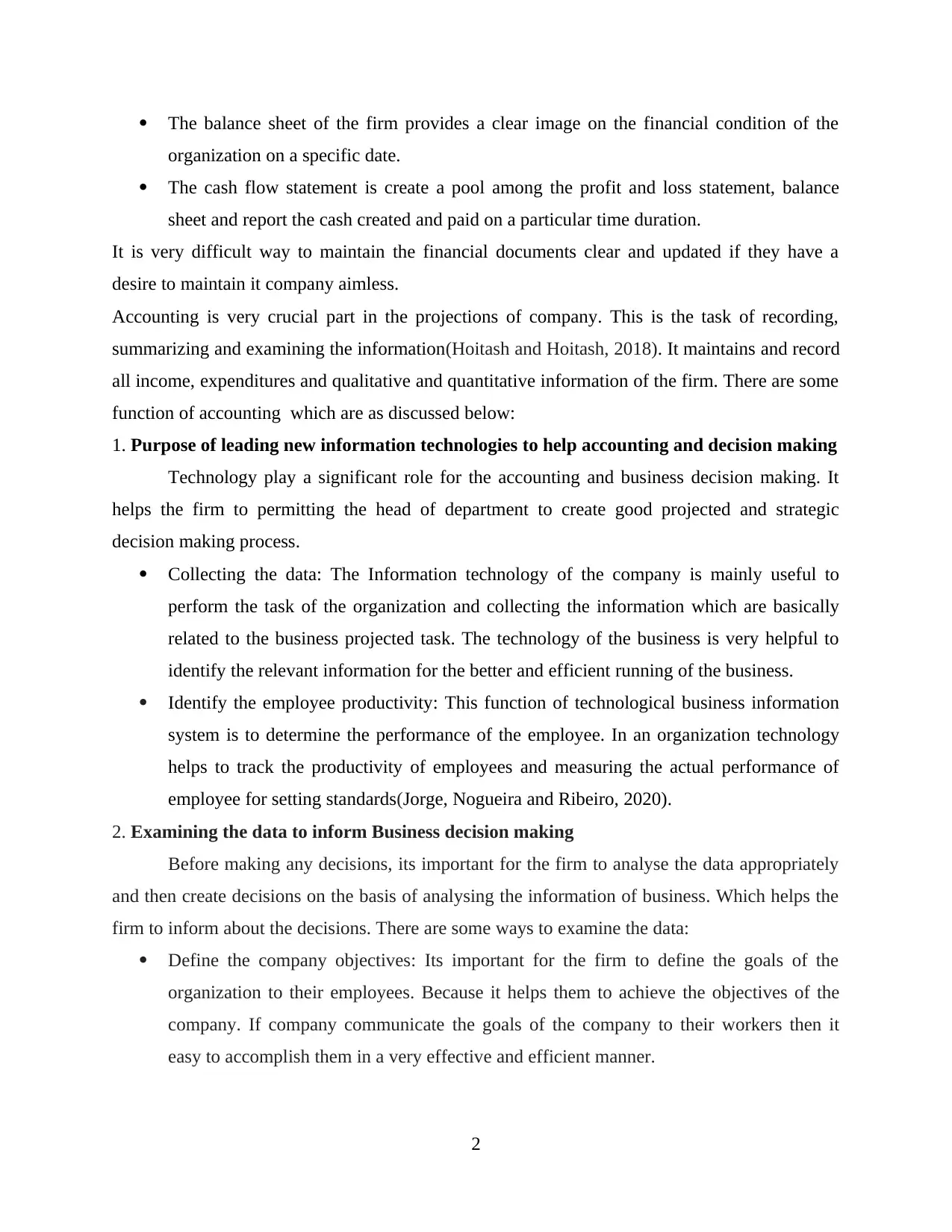
The balance sheet of the firm provides a clear image on the financial condition of the
organization on a specific date.
The cash flow statement is create a pool among the profit and loss statement, balance
sheet and report the cash created and paid on a particular time duration.
It is very difficult way to maintain the financial documents clear and updated if they have a
desire to maintain it company aimless.
Accounting is very crucial part in the projections of company. This is the task of recording,
summarizing and examining the information(Hoitash and Hoitash, 2018). It maintains and record
all income, expenditures and qualitative and quantitative information of the firm. There are some
function of accounting which are as discussed below:
1. Purpose of leading new information technologies to help accounting and decision making
Technology play a significant role for the accounting and business decision making. It
helps the firm to permitting the head of department to create good projected and strategic
decision making process.
Collecting the data: The Information technology of the company is mainly useful to
perform the task of the organization and collecting the information which are basically
related to the business projected task. The technology of the business is very helpful to
identify the relevant information for the better and efficient running of the business.
Identify the employee productivity: This function of technological business information
system is to determine the performance of the employee. In an organization technology
helps to track the productivity of employees and measuring the actual performance of
employee for setting standards(Jorge, Nogueira and Ribeiro, 2020).
2. Examining the data to inform Business decision making
Before making any decisions, its important for the firm to analyse the data appropriately
and then create decisions on the basis of analysing the information of business. Which helps the
firm to inform about the decisions. There are some ways to examine the data:
Define the company objectives: Its important for the firm to define the goals of the
organization to their employees. Because it helps them to achieve the objectives of the
company. If company communicate the goals of the company to their workers then it
easy to accomplish them in a very effective and efficient manner.
2
organization on a specific date.
The cash flow statement is create a pool among the profit and loss statement, balance
sheet and report the cash created and paid on a particular time duration.
It is very difficult way to maintain the financial documents clear and updated if they have a
desire to maintain it company aimless.
Accounting is very crucial part in the projections of company. This is the task of recording,
summarizing and examining the information(Hoitash and Hoitash, 2018). It maintains and record
all income, expenditures and qualitative and quantitative information of the firm. There are some
function of accounting which are as discussed below:
1. Purpose of leading new information technologies to help accounting and decision making
Technology play a significant role for the accounting and business decision making. It
helps the firm to permitting the head of department to create good projected and strategic
decision making process.
Collecting the data: The Information technology of the company is mainly useful to
perform the task of the organization and collecting the information which are basically
related to the business projected task. The technology of the business is very helpful to
identify the relevant information for the better and efficient running of the business.
Identify the employee productivity: This function of technological business information
system is to determine the performance of the employee. In an organization technology
helps to track the productivity of employees and measuring the actual performance of
employee for setting standards(Jorge, Nogueira and Ribeiro, 2020).
2. Examining the data to inform Business decision making
Before making any decisions, its important for the firm to analyse the data appropriately
and then create decisions on the basis of analysing the information of business. Which helps the
firm to inform about the decisions. There are some ways to examine the data:
Define the company objectives: Its important for the firm to define the goals of the
organization to their employees. Because it helps them to achieve the objectives of the
company. If company communicate the goals of the company to their workers then it
easy to accomplish them in a very effective and efficient manner.
2
Secure Best Marks with AI Grader
Need help grading? Try our AI Grader for instant feedback on your assignments.
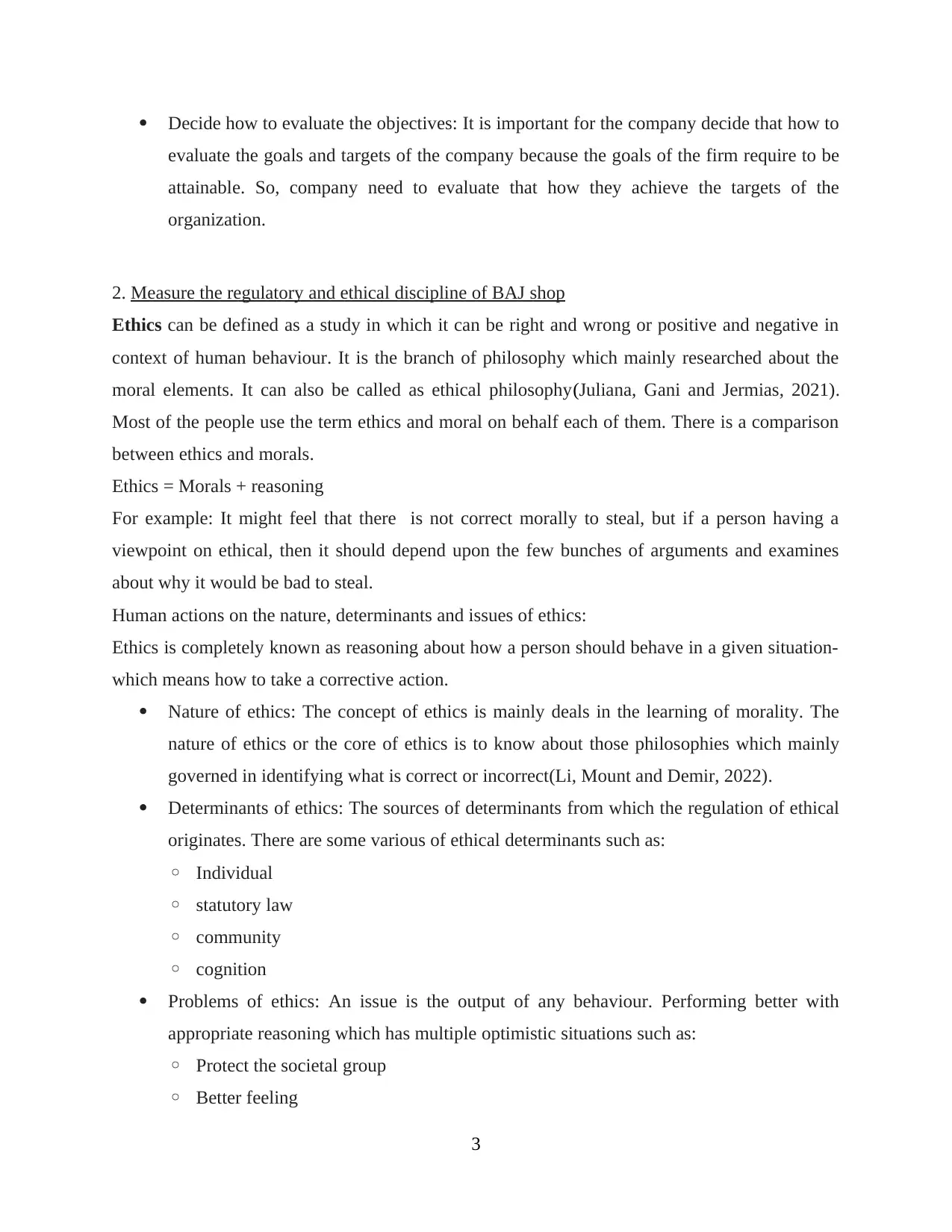
Decide how to evaluate the objectives: It is important for the company decide that how to
evaluate the goals and targets of the company because the goals of the firm require to be
attainable. So, company need to evaluate that how they achieve the targets of the
organization.
2. Measure the regulatory and ethical discipline of BAJ shop
Ethics can be defined as a study in which it can be right and wrong or positive and negative in
context of human behaviour. It is the branch of philosophy which mainly researched about the
moral elements. It can also be called as ethical philosophy(Juliana, Gani and Jermias, 2021).
Most of the people use the term ethics and moral on behalf each of them. There is a comparison
between ethics and morals.
Ethics = Morals + reasoning
For example: It might feel that there is not correct morally to steal, but if a person having a
viewpoint on ethical, then it should depend upon the few bunches of arguments and examines
about why it would be bad to steal.
Human actions on the nature, determinants and issues of ethics:
Ethics is completely known as reasoning about how a person should behave in a given situation-
which means how to take a corrective action.
Nature of ethics: The concept of ethics is mainly deals in the learning of morality. The
nature of ethics or the core of ethics is to know about those philosophies which mainly
governed in identifying what is correct or incorrect(Li, Mount and Demir, 2022).
Determinants of ethics: The sources of determinants from which the regulation of ethical
originates. There are some various of ethical determinants such as:
◦ Individual
◦ statutory law
◦ community
◦ cognition
Problems of ethics: An issue is the output of any behaviour. Performing better with
appropriate reasoning which has multiple optimistic situations such as:
◦ Protect the societal group
◦ Better feeling
3
evaluate the goals and targets of the company because the goals of the firm require to be
attainable. So, company need to evaluate that how they achieve the targets of the
organization.
2. Measure the regulatory and ethical discipline of BAJ shop
Ethics can be defined as a study in which it can be right and wrong or positive and negative in
context of human behaviour. It is the branch of philosophy which mainly researched about the
moral elements. It can also be called as ethical philosophy(Juliana, Gani and Jermias, 2021).
Most of the people use the term ethics and moral on behalf each of them. There is a comparison
between ethics and morals.
Ethics = Morals + reasoning
For example: It might feel that there is not correct morally to steal, but if a person having a
viewpoint on ethical, then it should depend upon the few bunches of arguments and examines
about why it would be bad to steal.
Human actions on the nature, determinants and issues of ethics:
Ethics is completely known as reasoning about how a person should behave in a given situation-
which means how to take a corrective action.
Nature of ethics: The concept of ethics is mainly deals in the learning of morality. The
nature of ethics or the core of ethics is to know about those philosophies which mainly
governed in identifying what is correct or incorrect(Li, Mount and Demir, 2022).
Determinants of ethics: The sources of determinants from which the regulation of ethical
originates. There are some various of ethical determinants such as:
◦ Individual
◦ statutory law
◦ community
◦ cognition
Problems of ethics: An issue is the output of any behaviour. Performing better with
appropriate reasoning which has multiple optimistic situations such as:
◦ Protect the societal group
◦ Better feeling
3
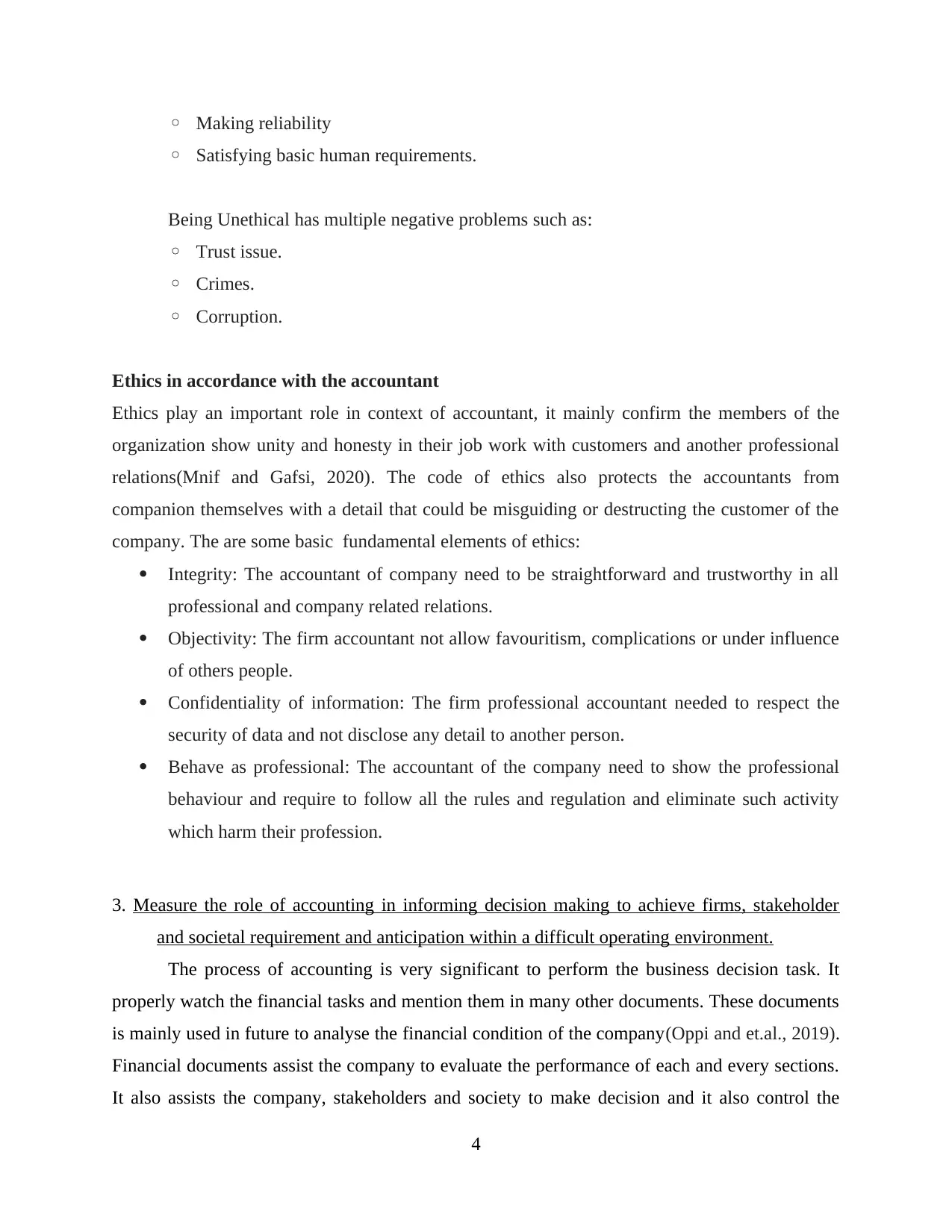
◦ Making reliability
◦ Satisfying basic human requirements.
Being Unethical has multiple negative problems such as:
◦ Trust issue.
◦ Crimes.
◦ Corruption.
Ethics in accordance with the accountant
Ethics play an important role in context of accountant, it mainly confirm the members of the
organization show unity and honesty in their job work with customers and another professional
relations(Mnif and Gafsi, 2020). The code of ethics also protects the accountants from
companion themselves with a detail that could be misguiding or destructing the customer of the
company. The are some basic fundamental elements of ethics:
Integrity: The accountant of company need to be straightforward and trustworthy in all
professional and company related relations.
Objectivity: The firm accountant not allow favouritism, complications or under influence
of others people.
Confidentiality of information: The firm professional accountant needed to respect the
security of data and not disclose any detail to another person.
Behave as professional: The accountant of the company need to show the professional
behaviour and require to follow all the rules and regulation and eliminate such activity
which harm their profession.
3. Measure the role of accounting in informing decision making to achieve firms, stakeholder
and societal requirement and anticipation within a difficult operating environment.
The process of accounting is very significant to perform the business decision task. It
properly watch the financial tasks and mention them in many other documents. These documents
is mainly used in future to analyse the financial condition of the company(Oppi and et.al., 2019).
Financial documents assist the company to evaluate the performance of each and every sections.
It also assists the company, stakeholders and society to make decision and it also control the
4
◦ Satisfying basic human requirements.
Being Unethical has multiple negative problems such as:
◦ Trust issue.
◦ Crimes.
◦ Corruption.
Ethics in accordance with the accountant
Ethics play an important role in context of accountant, it mainly confirm the members of the
organization show unity and honesty in their job work with customers and another professional
relations(Mnif and Gafsi, 2020). The code of ethics also protects the accountants from
companion themselves with a detail that could be misguiding or destructing the customer of the
company. The are some basic fundamental elements of ethics:
Integrity: The accountant of company need to be straightforward and trustworthy in all
professional and company related relations.
Objectivity: The firm accountant not allow favouritism, complications or under influence
of others people.
Confidentiality of information: The firm professional accountant needed to respect the
security of data and not disclose any detail to another person.
Behave as professional: The accountant of the company need to show the professional
behaviour and require to follow all the rules and regulation and eliminate such activity
which harm their profession.
3. Measure the role of accounting in informing decision making to achieve firms, stakeholder
and societal requirement and anticipation within a difficult operating environment.
The process of accounting is very significant to perform the business decision task. It
properly watch the financial tasks and mention them in many other documents. These documents
is mainly used in future to analyse the financial condition of the company(Oppi and et.al., 2019).
Financial documents assist the company to evaluate the performance of each and every sections.
It also assists the company, stakeholders and society to make decision and it also control the
4
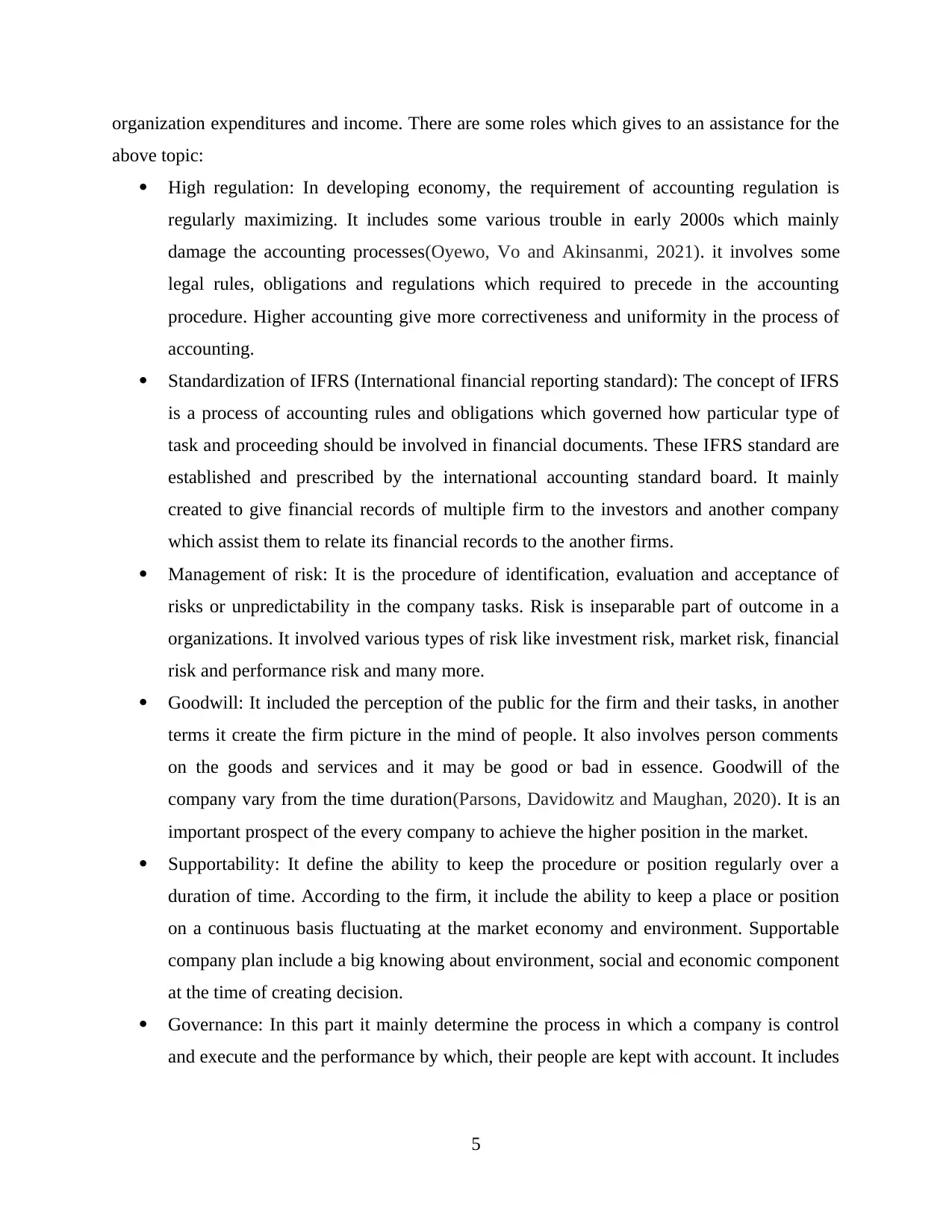
organization expenditures and income. There are some roles which gives to an assistance for the
above topic:
High regulation: In developing economy, the requirement of accounting regulation is
regularly maximizing. It includes some various trouble in early 2000s which mainly
damage the accounting processes(Oyewo, Vo and Akinsanmi, 2021). it involves some
legal rules, obligations and regulations which required to precede in the accounting
procedure. Higher accounting give more correctiveness and uniformity in the process of
accounting.
Standardization of IFRS (International financial reporting standard): The concept of IFRS
is a process of accounting rules and obligations which governed how particular type of
task and proceeding should be involved in financial documents. These IFRS standard are
established and prescribed by the international accounting standard board. It mainly
created to give financial records of multiple firm to the investors and another company
which assist them to relate its financial records to the another firms.
Management of risk: It is the procedure of identification, evaluation and acceptance of
risks or unpredictability in the company tasks. Risk is inseparable part of outcome in a
organizations. It involved various types of risk like investment risk, market risk, financial
risk and performance risk and many more.
Goodwill: It included the perception of the public for the firm and their tasks, in another
terms it create the firm picture in the mind of people. It also involves person comments
on the goods and services and it may be good or bad in essence. Goodwill of the
company vary from the time duration(Parsons, Davidowitz and Maughan, 2020). It is an
important prospect of the every company to achieve the higher position in the market.
Supportability: It define the ability to keep the procedure or position regularly over a
duration of time. According to the firm, it include the ability to keep a place or position
on a continuous basis fluctuating at the market economy and environment. Supportable
company plan include a big knowing about environment, social and economic component
at the time of creating decision.
Governance: In this part it mainly determine the process in which a company is control
and execute and the performance by which, their people are kept with account. It includes
5
above topic:
High regulation: In developing economy, the requirement of accounting regulation is
regularly maximizing. It includes some various trouble in early 2000s which mainly
damage the accounting processes(Oyewo, Vo and Akinsanmi, 2021). it involves some
legal rules, obligations and regulations which required to precede in the accounting
procedure. Higher accounting give more correctiveness and uniformity in the process of
accounting.
Standardization of IFRS (International financial reporting standard): The concept of IFRS
is a process of accounting rules and obligations which governed how particular type of
task and proceeding should be involved in financial documents. These IFRS standard are
established and prescribed by the international accounting standard board. It mainly
created to give financial records of multiple firm to the investors and another company
which assist them to relate its financial records to the another firms.
Management of risk: It is the procedure of identification, evaluation and acceptance of
risks or unpredictability in the company tasks. Risk is inseparable part of outcome in a
organizations. It involved various types of risk like investment risk, market risk, financial
risk and performance risk and many more.
Goodwill: It included the perception of the public for the firm and their tasks, in another
terms it create the firm picture in the mind of people. It also involves person comments
on the goods and services and it may be good or bad in essence. Goodwill of the
company vary from the time duration(Parsons, Davidowitz and Maughan, 2020). It is an
important prospect of the every company to achieve the higher position in the market.
Supportability: It define the ability to keep the procedure or position regularly over a
duration of time. According to the firm, it include the ability to keep a place or position
on a continuous basis fluctuating at the market economy and environment. Supportable
company plan include a big knowing about environment, social and economic component
at the time of creating decision.
Governance: In this part it mainly determine the process in which a company is control
and execute and the performance by which, their people are kept with account. It includes
5
Paraphrase This Document
Need a fresh take? Get an instant paraphrase of this document with our AI Paraphraser
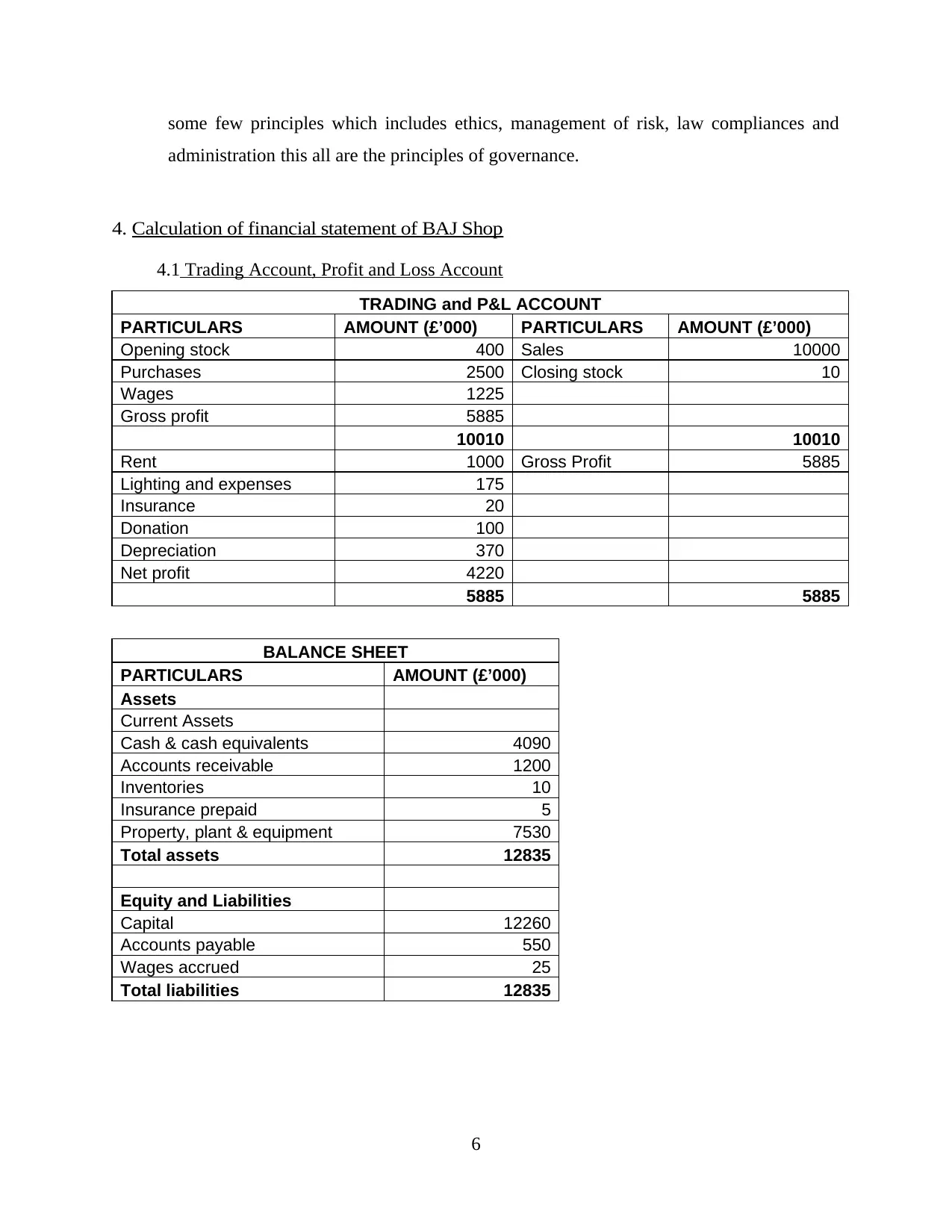
some few principles which includes ethics, management of risk, law compliances and
administration this all are the principles of governance.
4. Calculation of financial statement of BAJ Shop
4.1 Trading Account, Profit and Loss Account
TRADING and P&L ACCOUNT
PARTICULARS AMOUNT (£’000) PARTICULARS AMOUNT (£’000)
Opening stock 400 Sales 10000
Purchases 2500 Closing stock 10
Wages 1225
Gross profit 5885
10010 10010
Rent 1000 Gross Profit 5885
Lighting and expenses 175
Insurance 20
Donation 100
Depreciation 370
Net profit 4220
5885 5885
BALANCE SHEET
PARTICULARS AMOUNT (£’000)
Assets
Current Assets
Cash & cash equivalents 4090
Accounts receivable 1200
Inventories 10
Insurance prepaid 5
Property, plant & equipment 7530
Total assets 12835
Equity and Liabilities
Capital 12260
Accounts payable 550
Wages accrued 25
Total liabilities 12835
6
administration this all are the principles of governance.
4. Calculation of financial statement of BAJ Shop
4.1 Trading Account, Profit and Loss Account
TRADING and P&L ACCOUNT
PARTICULARS AMOUNT (£’000) PARTICULARS AMOUNT (£’000)
Opening stock 400 Sales 10000
Purchases 2500 Closing stock 10
Wages 1225
Gross profit 5885
10010 10010
Rent 1000 Gross Profit 5885
Lighting and expenses 175
Insurance 20
Donation 100
Depreciation 370
Net profit 4220
5885 5885
BALANCE SHEET
PARTICULARS AMOUNT (£’000)
Assets
Current Assets
Cash & cash equivalents 4090
Accounts receivable 1200
Inventories 10
Insurance prepaid 5
Property, plant & equipment 7530
Total assets 12835
Equity and Liabilities
Capital 12260
Accounts payable 550
Wages accrued 25
Total liabilities 12835
6
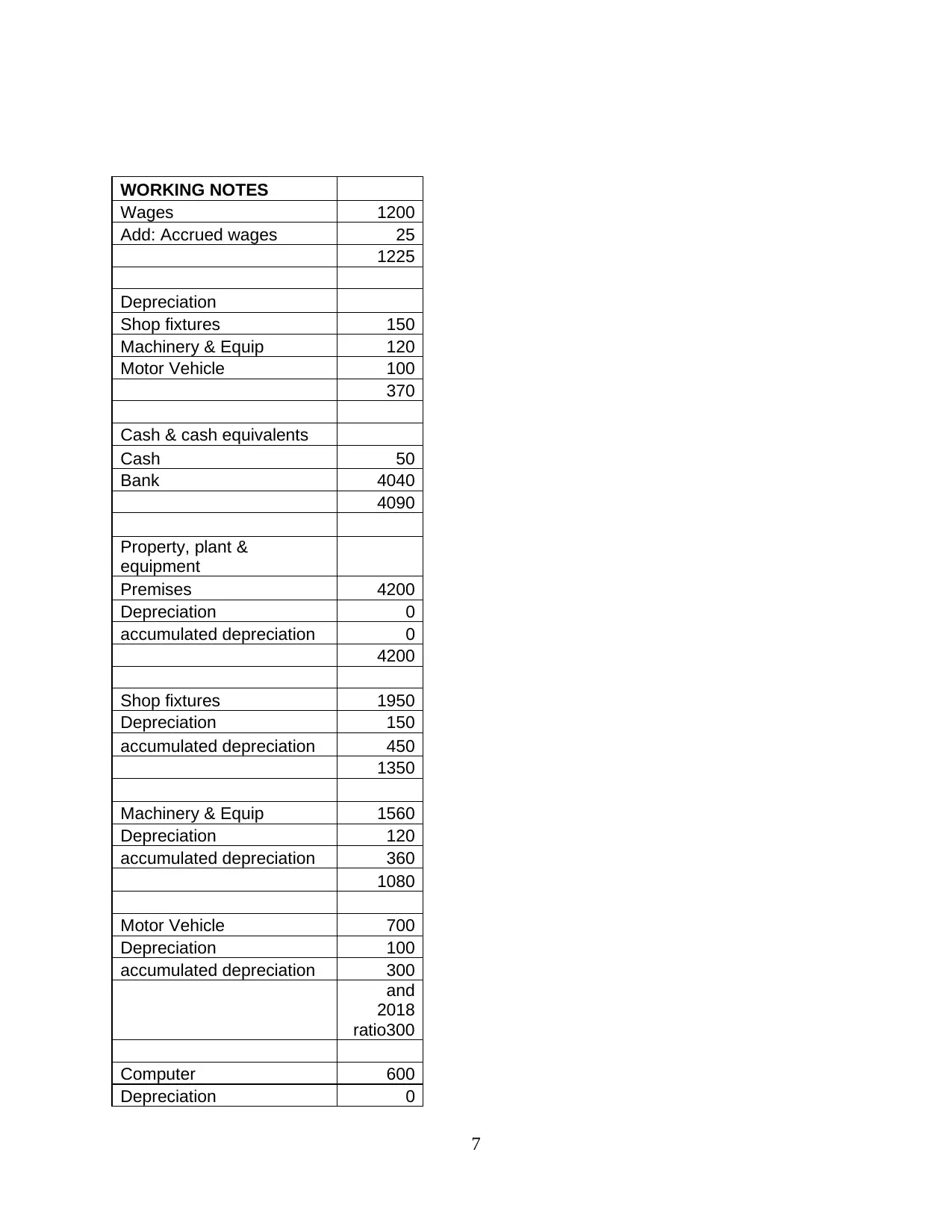
WORKING NOTES
Wages 1200
Add: Accrued wages 25
1225
Depreciation
Shop fixtures 150
Machinery & Equip 120
Motor Vehicle 100
370
Cash & cash equivalents
Cash 50
Bank 4040
4090
Property, plant &
equipment
Premises 4200
Depreciation 0
accumulated depreciation 0
4200
Shop fixtures 1950
Depreciation 150
accumulated depreciation 450
1350
Machinery & Equip 1560
Depreciation 120
accumulated depreciation 360
1080
Motor Vehicle 700
Depreciation 100
accumulated depreciation 300
and
2018
ratio300
Computer 600
Depreciation 0
7
Wages 1200
Add: Accrued wages 25
1225
Depreciation
Shop fixtures 150
Machinery & Equip 120
Motor Vehicle 100
370
Cash & cash equivalents
Cash 50
Bank 4040
4090
Property, plant &
equipment
Premises 4200
Depreciation 0
accumulated depreciation 0
4200
Shop fixtures 1950
Depreciation 150
accumulated depreciation 450
1350
Machinery & Equip 1560
Depreciation 120
accumulated depreciation 360
1080
Motor Vehicle 700
Depreciation 100
accumulated depreciation 300
and
2018
ratio300
Computer 600
Depreciation 0
7
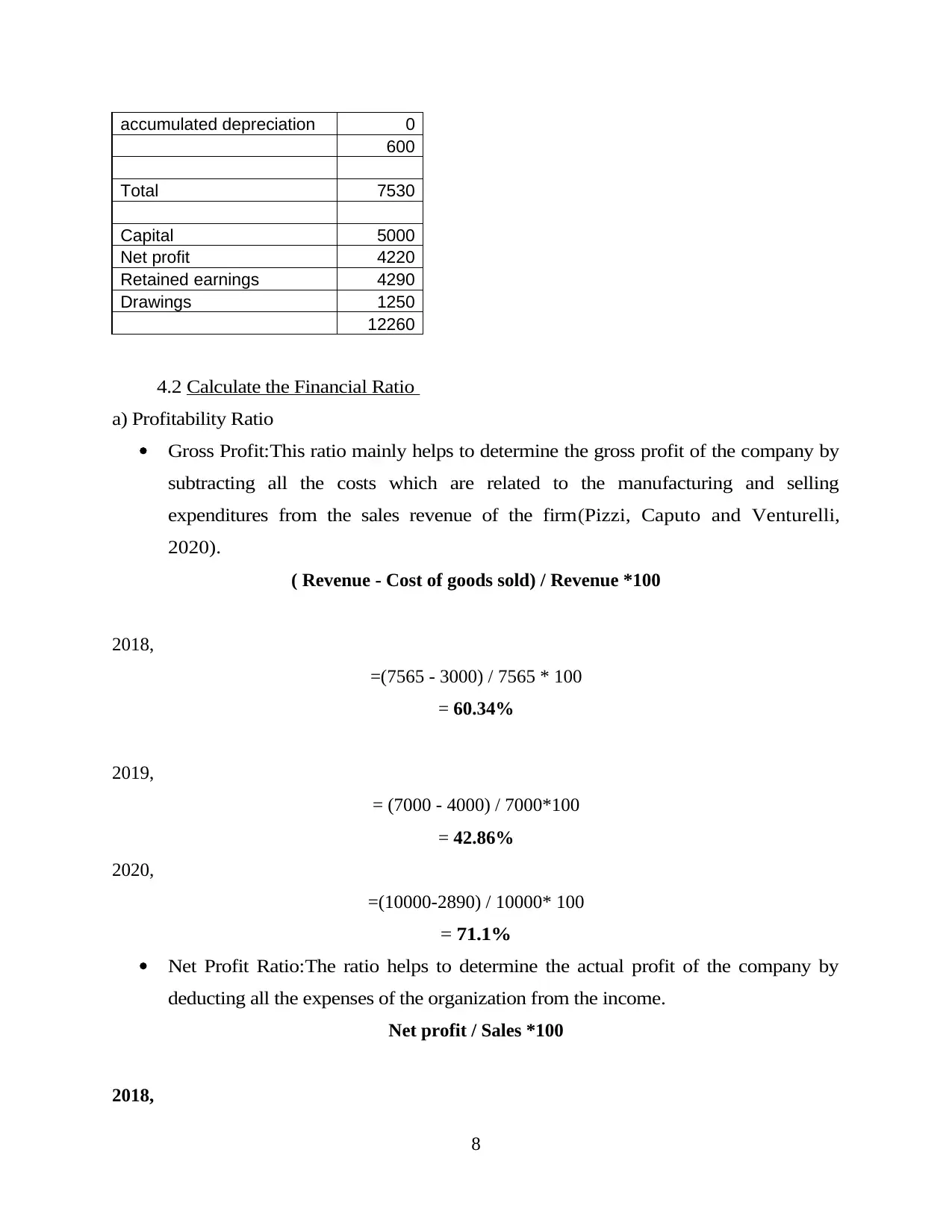
accumulated depreciation 0
600
Total 7530
Capital 5000
Net profit 4220
Retained earnings 4290
Drawings 1250
12260
4.2 Calculate the Financial Ratio
a) Profitability Ratio
Gross Profit:This ratio mainly helps to determine the gross profit of the company by
subtracting all the costs which are related to the manufacturing and selling
expenditures from the sales revenue of the firm(Pizzi, Caputo and Venturelli,
2020).
( Revenue - Cost of goods sold) / Revenue *100
2018,
=(7565 - 3000) / 7565 * 100
= 60.34%
2019,
= (7000 - 4000) / 7000*100
= 42.86%
2020,
=(10000-2890) / 10000* 100
= 71.1%
Net Profit Ratio:The ratio helps to determine the actual profit of the company by
deducting all the expenses of the organization from the income.
Net profit / Sales *100
2018,
8
600
Total 7530
Capital 5000
Net profit 4220
Retained earnings 4290
Drawings 1250
12260
4.2 Calculate the Financial Ratio
a) Profitability Ratio
Gross Profit:This ratio mainly helps to determine the gross profit of the company by
subtracting all the costs which are related to the manufacturing and selling
expenditures from the sales revenue of the firm(Pizzi, Caputo and Venturelli,
2020).
( Revenue - Cost of goods sold) / Revenue *100
2018,
=(7565 - 3000) / 7565 * 100
= 60.34%
2019,
= (7000 - 4000) / 7000*100
= 42.86%
2020,
=(10000-2890) / 10000* 100
= 71.1%
Net Profit Ratio:The ratio helps to determine the actual profit of the company by
deducting all the expenses of the organization from the income.
Net profit / Sales *100
2018,
8
Secure Best Marks with AI Grader
Need help grading? Try our AI Grader for instant feedback on your assignments.
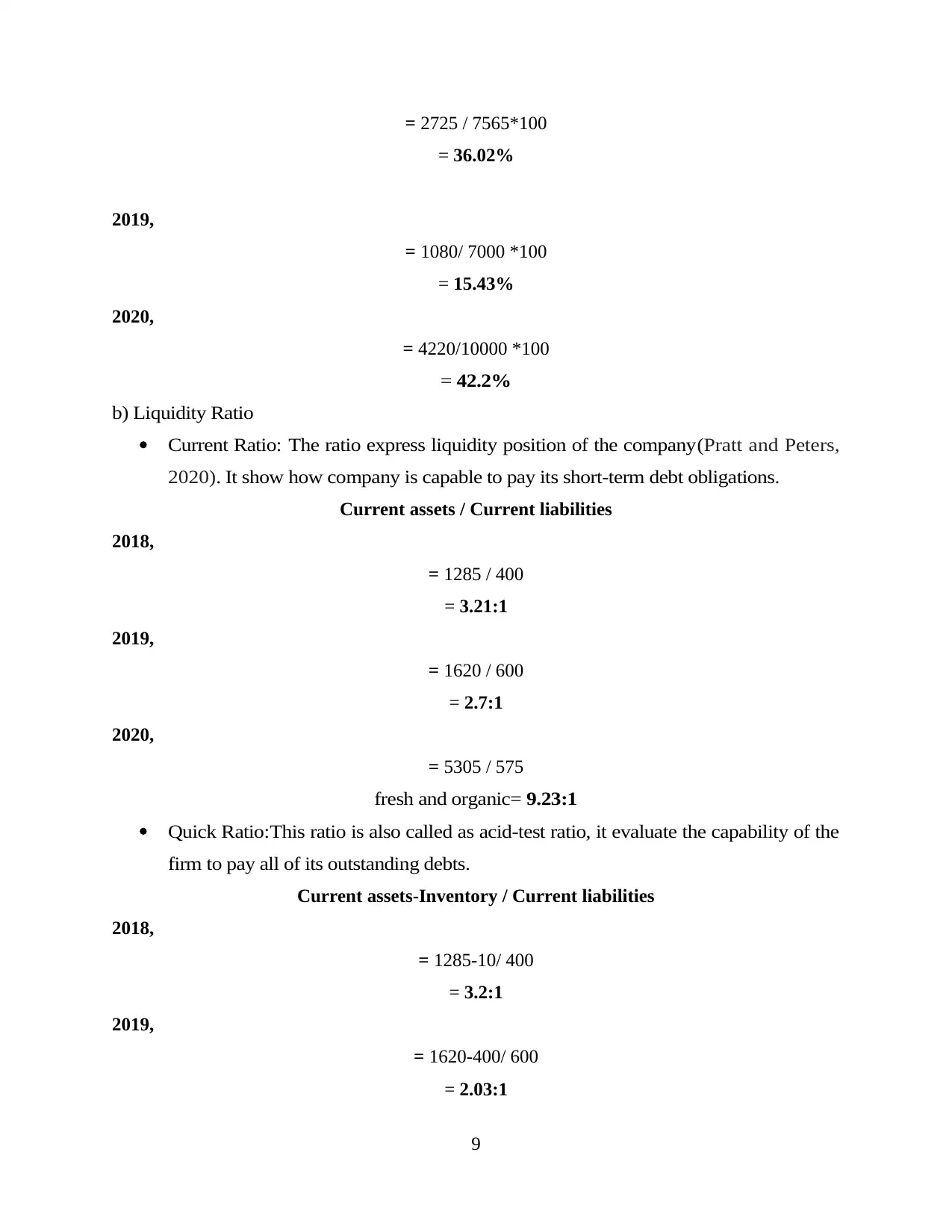
= 2725 / 7565*100
= 36.02%
2019,
= 1080/ 7000 *100
= 15.43%
2020,
= 4220/10000 *100
= 42.2%
b) Liquidity Ratio
Current Ratio: The ratio express liquidity position of the company(Pratt and Peters,
2020). It show how company is capable to pay its short-term debt obligations.
Current assets / Current liabilities
2018,
= 1285 / 400
= 3.21:1
2019,
= 1620 / 600
= 2.7:1
2020,
= 5305 / 575
fresh and organic= 9.23:1
Quick Ratio:This ratio is also called as acid-test ratio, it evaluate the capability of the
firm to pay all of its outstanding debts.
Current assets-Inventory / Current liabilities
2018,
= 1285-10/ 400
= 3.2:1
2019,
= 1620-400/ 600
= 2.03:1
9
= 36.02%
2019,
= 1080/ 7000 *100
= 15.43%
2020,
= 4220/10000 *100
= 42.2%
b) Liquidity Ratio
Current Ratio: The ratio express liquidity position of the company(Pratt and Peters,
2020). It show how company is capable to pay its short-term debt obligations.
Current assets / Current liabilities
2018,
= 1285 / 400
= 3.21:1
2019,
= 1620 / 600
= 2.7:1
2020,
= 5305 / 575
fresh and organic= 9.23:1
Quick Ratio:This ratio is also called as acid-test ratio, it evaluate the capability of the
firm to pay all of its outstanding debts.
Current assets-Inventory / Current liabilities
2018,
= 1285-10/ 400
= 3.2:1
2019,
= 1620-400/ 600
= 2.03:1
9
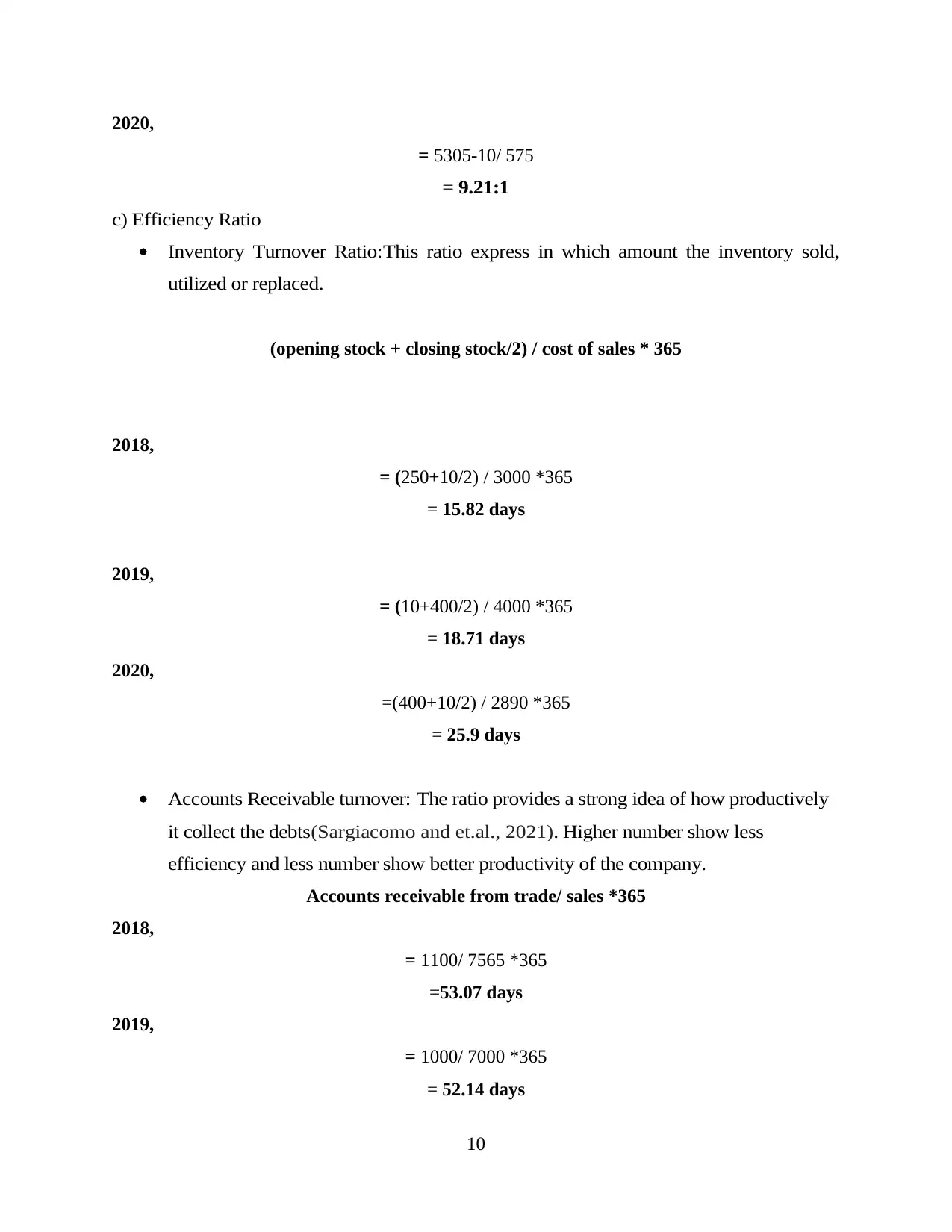
2020,
= 5305-10/ 575
= 9.21:1
c) Efficiency Ratio
Inventory Turnover Ratio:This ratio express in which amount the inventory sold,
utilized or replaced.
(opening stock + closing stock/2) / cost of sales * 365
2018,
= (250+10/2) / 3000 *365
= 15.82 days
2019,
= (10+400/2) / 4000 *365
= 18.71 days
2020,
=(400+10/2) / 2890 *365
= 25.9 days
Accounts Receivable turnover: The ratio provides a strong idea of how productively
it collect the debts(Sargiacomo and et.al., 2021). Higher number show less
efficiency and less number show better productivity of the company.
Accounts receivable from trade/ sales *365
2018,
= 1100/ 7565 *365
=53.07 days
2019,
= 1000/ 7000 *365
= 52.14 days
10
= 5305-10/ 575
= 9.21:1
c) Efficiency Ratio
Inventory Turnover Ratio:This ratio express in which amount the inventory sold,
utilized or replaced.
(opening stock + closing stock/2) / cost of sales * 365
2018,
= (250+10/2) / 3000 *365
= 15.82 days
2019,
= (10+400/2) / 4000 *365
= 18.71 days
2020,
=(400+10/2) / 2890 *365
= 25.9 days
Accounts Receivable turnover: The ratio provides a strong idea of how productively
it collect the debts(Sargiacomo and et.al., 2021). Higher number show less
efficiency and less number show better productivity of the company.
Accounts receivable from trade/ sales *365
2018,
= 1100/ 7565 *365
=53.07 days
2019,
= 1000/ 7000 *365
= 52.14 days
10
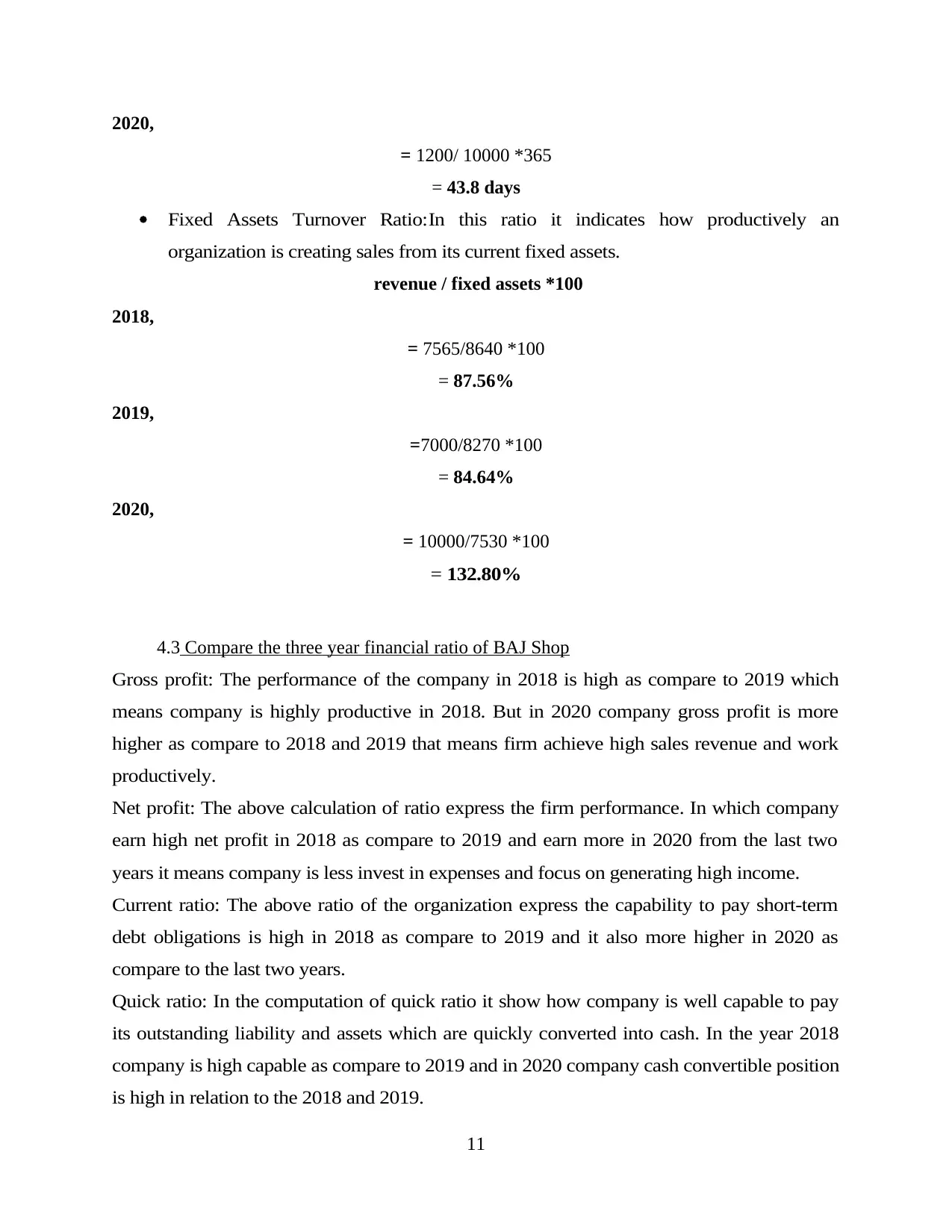
2020,
= 1200/ 10000 *365
= 43.8 days
Fixed Assets Turnover Ratio:In this ratio it indicates how productively an
organization is creating sales from its current fixed assets.
revenue / fixed assets *100
2018,
= 7565/8640 *100
= 87.56%
2019,
=7000/8270 *100
= 84.64%
2020,
= 10000/7530 *100
= 132.80%
4.3 Compare the three year financial ratio of BAJ Shop
Gross profit: The performance of the company in 2018 is high as compare to 2019 which
means company is highly productive in 2018. But in 2020 company gross profit is more
higher as compare to 2018 and 2019 that means firm achieve high sales revenue and work
productively.
Net profit: The above calculation of ratio express the firm performance. In which company
earn high net profit in 2018 as compare to 2019 and earn more in 2020 from the last two
years it means company is less invest in expenses and focus on generating high income.
Current ratio: The above ratio of the organization express the capability to pay short-term
debt obligations is high in 2018 as compare to 2019 and it also more higher in 2020 as
compare to the last two years.
Quick ratio: In the computation of quick ratio it show how company is well capable to pay
its outstanding liability and assets which are quickly converted into cash. In the year 2018
company is high capable as compare to 2019 and in 2020 company cash convertible position
is high in relation to the 2018 and 2019.
11
= 1200/ 10000 *365
= 43.8 days
Fixed Assets Turnover Ratio:In this ratio it indicates how productively an
organization is creating sales from its current fixed assets.
revenue / fixed assets *100
2018,
= 7565/8640 *100
= 87.56%
2019,
=7000/8270 *100
= 84.64%
2020,
= 10000/7530 *100
= 132.80%
4.3 Compare the three year financial ratio of BAJ Shop
Gross profit: The performance of the company in 2018 is high as compare to 2019 which
means company is highly productive in 2018. But in 2020 company gross profit is more
higher as compare to 2018 and 2019 that means firm achieve high sales revenue and work
productively.
Net profit: The above calculation of ratio express the firm performance. In which company
earn high net profit in 2018 as compare to 2019 and earn more in 2020 from the last two
years it means company is less invest in expenses and focus on generating high income.
Current ratio: The above ratio of the organization express the capability to pay short-term
debt obligations is high in 2018 as compare to 2019 and it also more higher in 2020 as
compare to the last two years.
Quick ratio: In the computation of quick ratio it show how company is well capable to pay
its outstanding liability and assets which are quickly converted into cash. In the year 2018
company is high capable as compare to 2019 and in 2020 company cash convertible position
is high in relation to the 2018 and 2019.
11
Paraphrase This Document
Need a fresh take? Get an instant paraphrase of this document with our AI Paraphraser
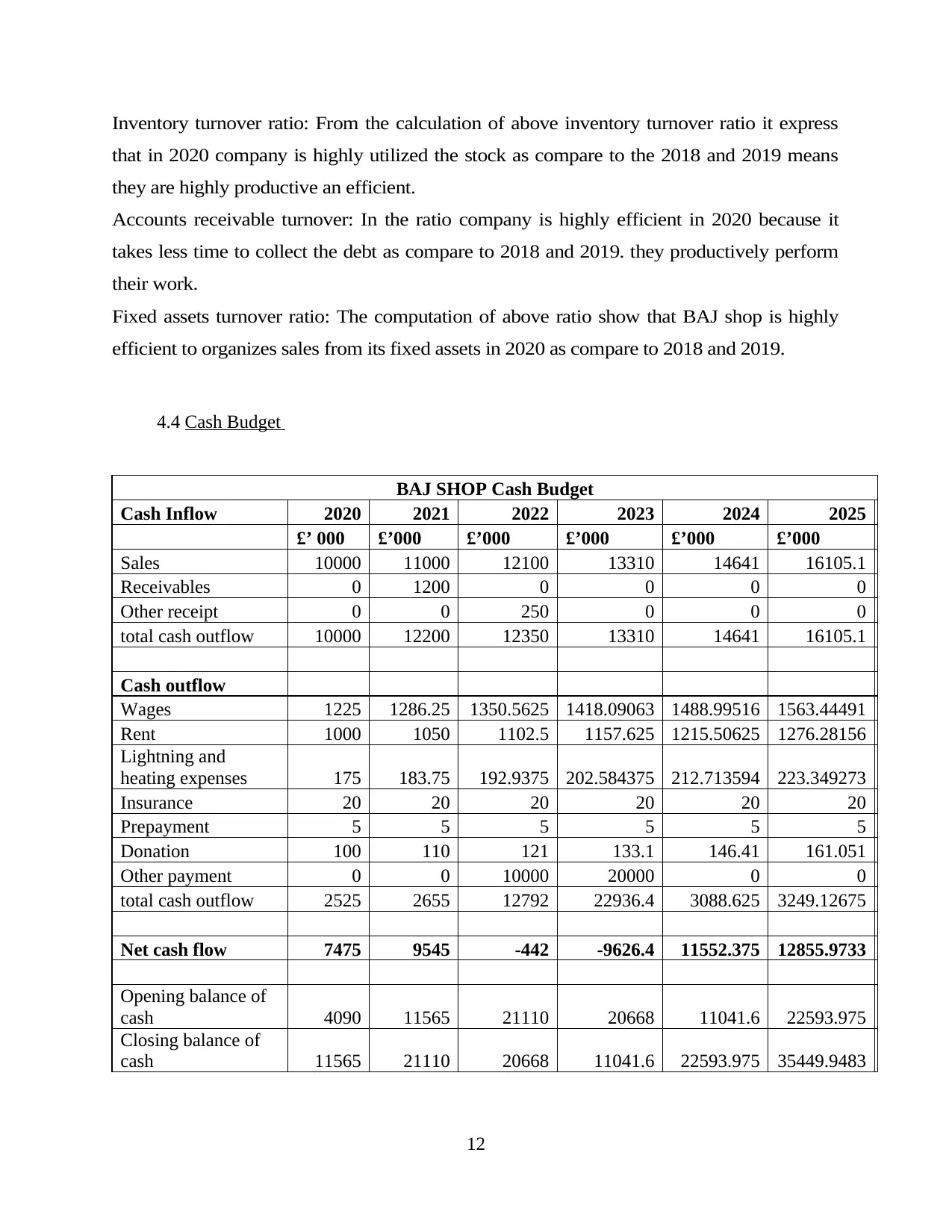
Inventory turnover ratio: From the calculation of above inventory turnover ratio it express
that in 2020 company is highly utilized the stock as compare to the 2018 and 2019 means
they are highly productive an efficient.
Accounts receivable turnover: In the ratio company is highly efficient in 2020 because it
takes less time to collect the debt as compare to 2018 and 2019. they productively perform
their work.
Fixed assets turnover ratio: The computation of above ratio show that BAJ shop is highly
efficient to organizes sales from its fixed assets in 2020 as compare to 2018 and 2019.
4.4 Cash Budget
BAJ SHOP Cash Budget
Cash Inflow 2020 2021 2022 2023 2024 2025
£’ 000 £’000 £’000 £’000 £’000 £’000
Sales 10000 11000 12100 13310 14641 16105.1
Receivables 0 1200 0 0 0 0
Other receipt 0 0 250 0 0 0
total cash outflow 10000 12200 12350 13310 14641 16105.1
Cash outflow
Wages 1225 1286.25 1350.5625 1418.09063 1488.99516 1563.44491
Rent 1000 1050 1102.5 1157.625 1215.50625 1276.28156
Lightning and
heating expenses 175 183.75 192.9375 202.584375 212.713594 223.349273
Insurance 20 20 20 20 20 20
Prepayment 5 5 5 5 5 5
Donation 100 110 121 133.1 146.41 161.051
Other payment 0 0 10000 20000 0 0
total cash outflow 2525 2655 12792 22936.4 3088.625 3249.12675
Net cash flow 7475 9545 -442 -9626.4 11552.375 12855.9733
Opening balance of
cash 4090 11565 21110 20668 11041.6 22593.975
Closing balance of
cash 11565 21110 20668 11041.6 22593.975 35449.9483
12
that in 2020 company is highly utilized the stock as compare to the 2018 and 2019 means
they are highly productive an efficient.
Accounts receivable turnover: In the ratio company is highly efficient in 2020 because it
takes less time to collect the debt as compare to 2018 and 2019. they productively perform
their work.
Fixed assets turnover ratio: The computation of above ratio show that BAJ shop is highly
efficient to organizes sales from its fixed assets in 2020 as compare to 2018 and 2019.
4.4 Cash Budget
BAJ SHOP Cash Budget
Cash Inflow 2020 2021 2022 2023 2024 2025
£’ 000 £’000 £’000 £’000 £’000 £’000
Sales 10000 11000 12100 13310 14641 16105.1
Receivables 0 1200 0 0 0 0
Other receipt 0 0 250 0 0 0
total cash outflow 10000 12200 12350 13310 14641 16105.1
Cash outflow
Wages 1225 1286.25 1350.5625 1418.09063 1488.99516 1563.44491
Rent 1000 1050 1102.5 1157.625 1215.50625 1276.28156
Lightning and
heating expenses 175 183.75 192.9375 202.584375 212.713594 223.349273
Insurance 20 20 20 20 20 20
Prepayment 5 5 5 5 5 5
Donation 100 110 121 133.1 146.41 161.051
Other payment 0 0 10000 20000 0 0
total cash outflow 2525 2655 12792 22936.4 3088.625 3249.12675
Net cash flow 7475 9545 -442 -9626.4 11552.375 12855.9733
Opening balance of
cash 4090 11565 21110 20668 11041.6 22593.975
Closing balance of
cash 11565 21110 20668 11041.6 22593.975 35449.9483
12
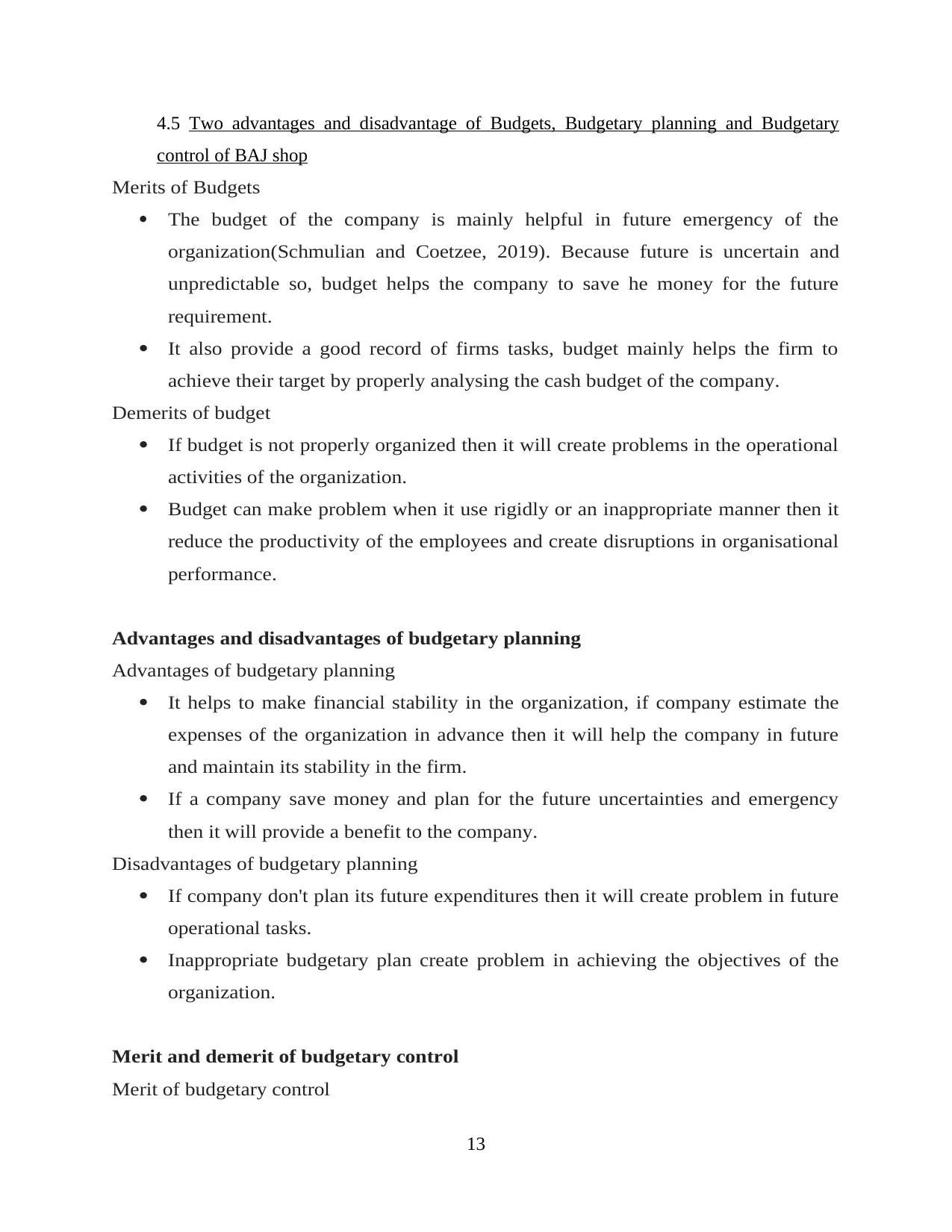
4.5 Two advantages and disadvantage of Budgets, Budgetary planning and Budgetary
control of BAJ shop
Merits of Budgets
The budget of the company is mainly helpful in future emergency of the
organization(Schmulian and Coetzee, 2019). Because future is uncertain and
unpredictable so, budget helps the company to save he money for the future
requirement.
It also provide a good record of firms tasks, budget mainly helps the firm to
achieve their target by properly analysing the cash budget of the company.
Demerits of budget
If budget is not properly organized then it will create problems in the operational
activities of the organization.
Budget can make problem when it use rigidly or an inappropriate manner then it
reduce the productivity of the employees and create disruptions in organisational
performance.
Advantages and disadvantages of budgetary planning
Advantages of budgetary planning
It helps to make financial stability in the organization, if company estimate the
expenses of the organization in advance then it will help the company in future
and maintain its stability in the firm.
If a company save money and plan for the future uncertainties and emergency
then it will provide a benefit to the company.
Disadvantages of budgetary planning
If company don't plan its future expenditures then it will create problem in future
operational tasks.
Inappropriate budgetary plan create problem in achieving the objectives of the
organization.
Merit and demerit of budgetary control
Merit of budgetary control
13
control of BAJ shop
Merits of Budgets
The budget of the company is mainly helpful in future emergency of the
organization(Schmulian and Coetzee, 2019). Because future is uncertain and
unpredictable so, budget helps the company to save he money for the future
requirement.
It also provide a good record of firms tasks, budget mainly helps the firm to
achieve their target by properly analysing the cash budget of the company.
Demerits of budget
If budget is not properly organized then it will create problems in the operational
activities of the organization.
Budget can make problem when it use rigidly or an inappropriate manner then it
reduce the productivity of the employees and create disruptions in organisational
performance.
Advantages and disadvantages of budgetary planning
Advantages of budgetary planning
It helps to make financial stability in the organization, if company estimate the
expenses of the organization in advance then it will help the company in future
and maintain its stability in the firm.
If a company save money and plan for the future uncertainties and emergency
then it will provide a benefit to the company.
Disadvantages of budgetary planning
If company don't plan its future expenditures then it will create problem in future
operational tasks.
Inappropriate budgetary plan create problem in achieving the objectives of the
organization.
Merit and demerit of budgetary control
Merit of budgetary control
13
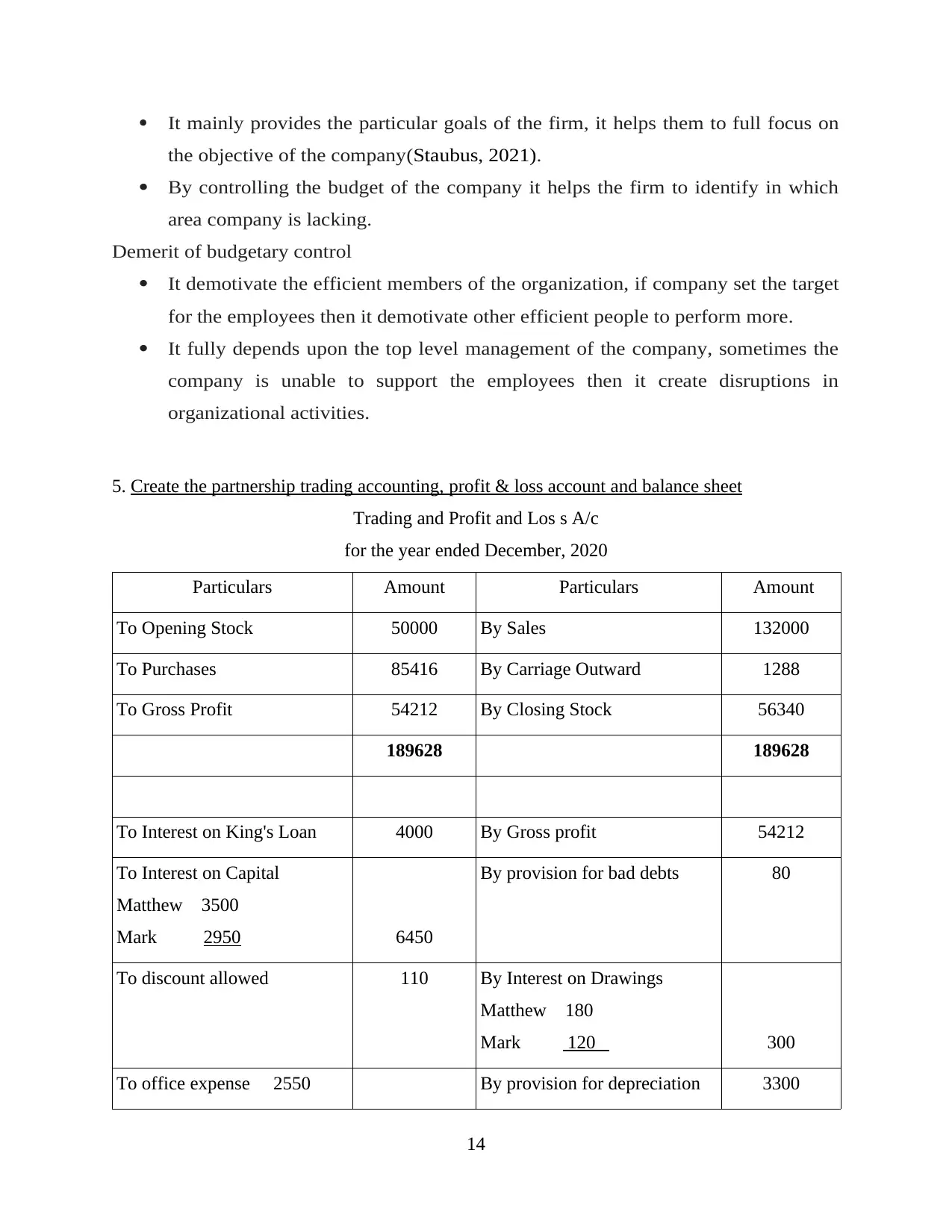
It mainly provides the particular goals of the firm, it helps them to full focus on
the objective of the company(Staubus, 2021).
By controlling the budget of the company it helps the firm to identify in which
area company is lacking.
Demerit of budgetary control
It demotivate the efficient members of the organization, if company set the target
for the employees then it demotivate other efficient people to perform more.
It fully depends upon the top level management of the company, sometimes the
company is unable to support the employees then it create disruptions in
organizational activities.
5. Create the partnership trading accounting, profit & loss account and balance sheet
Trading and Profit and Los s A/c
for the year ended December, 2020
Particulars Amount Particulars Amount
To Opening Stock 50000 By Sales 132000
To Purchases 85416 By Carriage Outward 1288
To Gross Profit 54212 By Closing Stock 56340
189628 189628
To Interest on King's Loan 4000 By Gross profit 54212
To Interest on Capital
Matthew 3500
Mark 2950 6450
By provision for bad debts 80
To discount allowed 110 By Interest on Drawings
Matthew 180
Mark 120 300
To office expense 2550 By provision for depreciation 3300
14
the objective of the company(Staubus, 2021).
By controlling the budget of the company it helps the firm to identify in which
area company is lacking.
Demerit of budgetary control
It demotivate the efficient members of the organization, if company set the target
for the employees then it demotivate other efficient people to perform more.
It fully depends upon the top level management of the company, sometimes the
company is unable to support the employees then it create disruptions in
organizational activities.
5. Create the partnership trading accounting, profit & loss account and balance sheet
Trading and Profit and Los s A/c
for the year ended December, 2020
Particulars Amount Particulars Amount
To Opening Stock 50000 By Sales 132000
To Purchases 85416 By Carriage Outward 1288
To Gross Profit 54212 By Closing Stock 56340
189628 189628
To Interest on King's Loan 4000 By Gross profit 54212
To Interest on Capital
Matthew 3500
Mark 2950 6450
By provision for bad debts 80
To discount allowed 110 By Interest on Drawings
Matthew 180
Mark 120 300
To office expense 2550 By provision for depreciation 3300
14
Secure Best Marks with AI Grader
Need help grading? Try our AI Grader for instant feedback on your assignments.
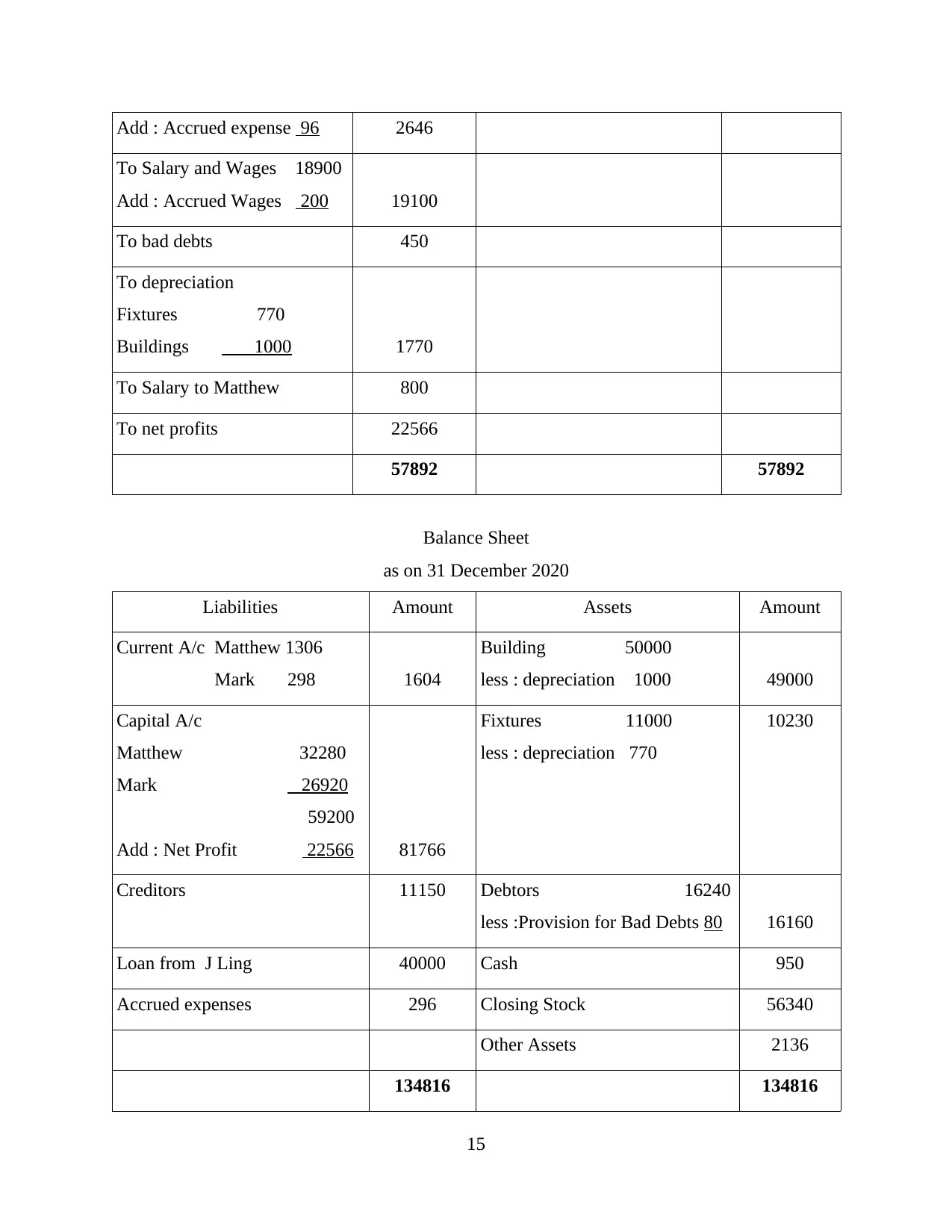
Add : Accrued expense 96 2646
To Salary and Wages 18900
Add : Accrued Wages 200 19100
To bad debts 450
To depreciation
Fixtures 770
Buildings 1000 1770
To Salary to Matthew 800
To net profits 22566
57892 57892
Balance Sheet
as on 31 December 2020
Liabilities Amount Assets Amount
Current A/c Matthew 1306
Mark 298 1604
Building 50000
less : depreciation 1000 49000
Capital A/c
Matthew 32280
Mark 26920
59200
Add : Net Profit 22566 81766
Fixtures 11000
less : depreciation 770
10230
Creditors 11150 Debtors 16240
less :Provision for Bad Debts 80 16160
Loan from J Ling 40000 Cash 950
Accrued expenses 296 Closing Stock 56340
Other Assets 2136
134816 134816
15
To Salary and Wages 18900
Add : Accrued Wages 200 19100
To bad debts 450
To depreciation
Fixtures 770
Buildings 1000 1770
To Salary to Matthew 800
To net profits 22566
57892 57892
Balance Sheet
as on 31 December 2020
Liabilities Amount Assets Amount
Current A/c Matthew 1306
Mark 298 1604
Building 50000
less : depreciation 1000 49000
Capital A/c
Matthew 32280
Mark 26920
59200
Add : Net Profit 22566 81766
Fixtures 11000
less : depreciation 770
10230
Creditors 11150 Debtors 16240
less :Provision for Bad Debts 80 16160
Loan from J Ling 40000 Cash 950
Accrued expenses 296 Closing Stock 56340
Other Assets 2136
134816 134816
15
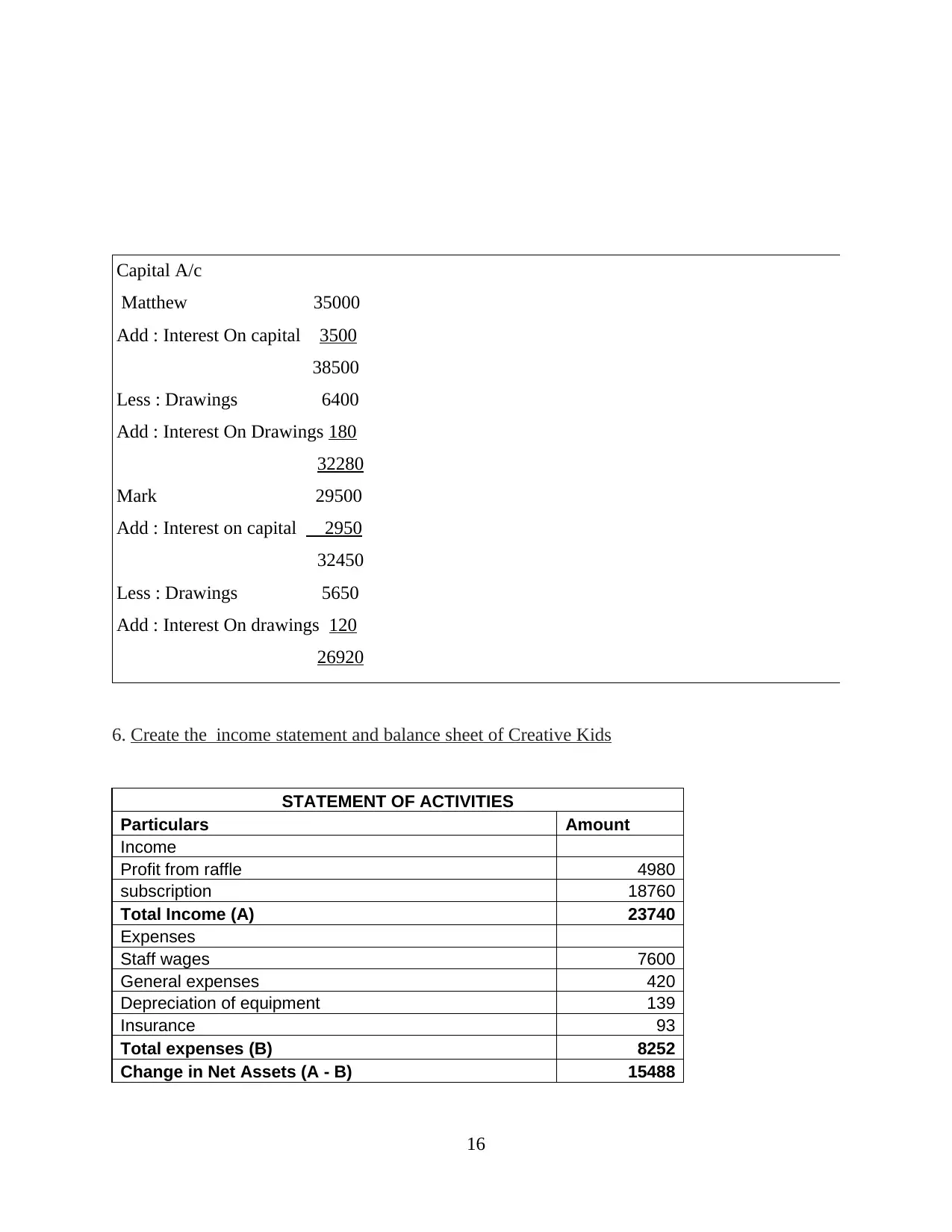
Capital A/c
Matthew 35000
Add : Interest On capital 3500
38500
Less : Drawings 6400
Add : Interest On Drawings 180
32280
Mark 29500
Add : Interest on capital 2950
32450
Less : Drawings 5650
Add : Interest On drawings 120
26920
6. Create the income statement and balance sheet of Creative Kids
STATEMENT OF ACTIVITIES
Particulars Amount
Income
Profit from raffle 4980
subscription 18760
Total Income (A) 23740
Expenses
Staff wages 7600
General expenses 420
Depreciation of equipment 139
Insurance 93
Total expenses (B) 8252
Change in Net Assets (A - B) 15488
16
Matthew 35000
Add : Interest On capital 3500
38500
Less : Drawings 6400
Add : Interest On Drawings 180
32280
Mark 29500
Add : Interest on capital 2950
32450
Less : Drawings 5650
Add : Interest On drawings 120
26920
6. Create the income statement and balance sheet of Creative Kids
STATEMENT OF ACTIVITIES
Particulars Amount
Income
Profit from raffle 4980
subscription 18760
Total Income (A) 23740
Expenses
Staff wages 7600
General expenses 420
Depreciation of equipment 139
Insurance 93
Total expenses (B) 8252
Change in Net Assets (A - B) 15488
16
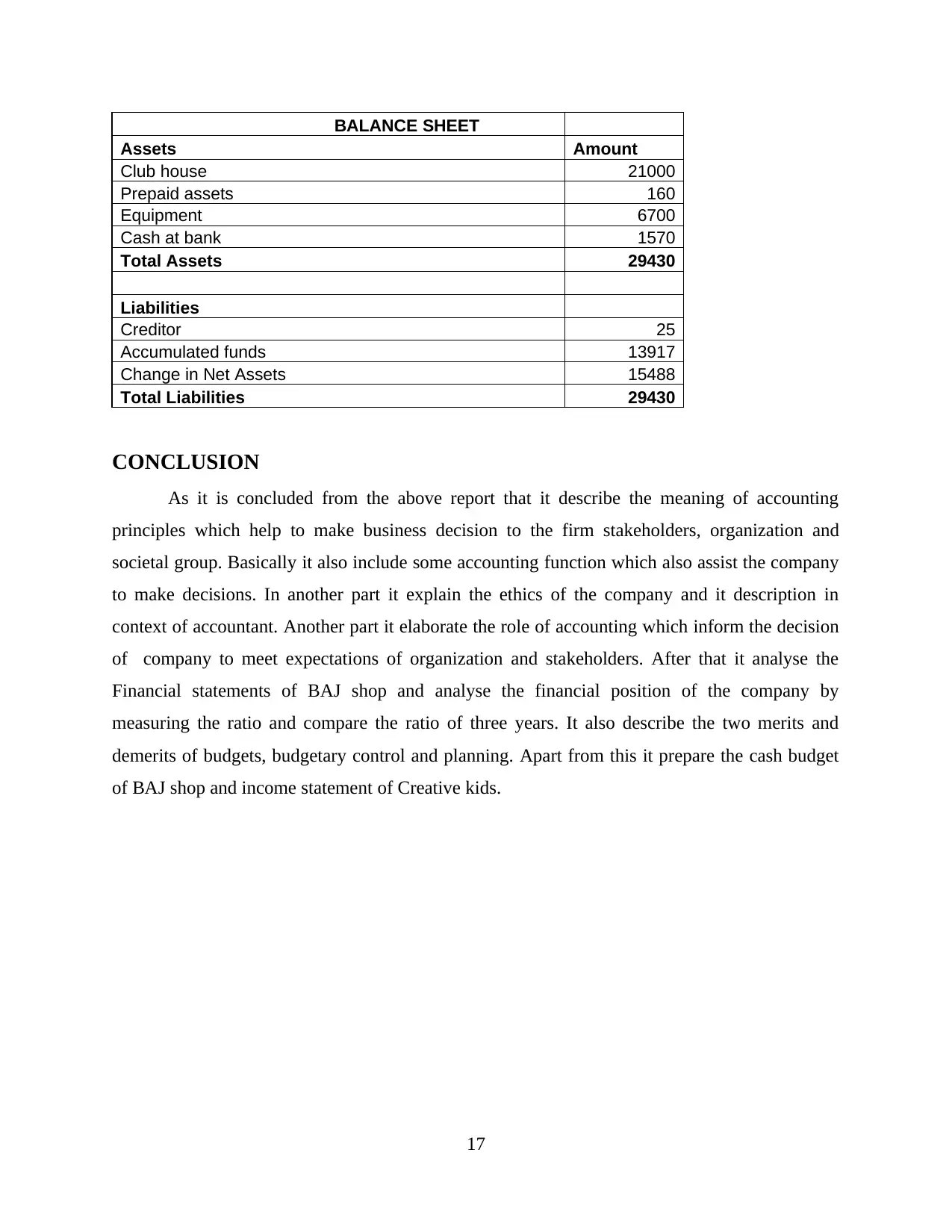
BALANCE SHEET
Assets Amount
Club house 21000
Prepaid assets 160
Equipment 6700
Cash at bank 1570
Total Assets 29430
Liabilities
Creditor 25
Accumulated funds 13917
Change in Net Assets 15488
Total Liabilities 29430
CONCLUSION
As it is concluded from the above report that it describe the meaning of accounting
principles which help to make business decision to the firm stakeholders, organization and
societal group. Basically it also include some accounting function which also assist the company
to make decisions. In another part it explain the ethics of the company and it description in
context of accountant. Another part it elaborate the role of accounting which inform the decision
of company to meet expectations of organization and stakeholders. After that it analyse the
Financial statements of BAJ shop and analyse the financial position of the company by
measuring the ratio and compare the ratio of three years. It also describe the two merits and
demerits of budgets, budgetary control and planning. Apart from this it prepare the cash budget
of BAJ shop and income statement of Creative kids.
17
Assets Amount
Club house 21000
Prepaid assets 160
Equipment 6700
Cash at bank 1570
Total Assets 29430
Liabilities
Creditor 25
Accumulated funds 13917
Change in Net Assets 15488
Total Liabilities 29430
CONCLUSION
As it is concluded from the above report that it describe the meaning of accounting
principles which help to make business decision to the firm stakeholders, organization and
societal group. Basically it also include some accounting function which also assist the company
to make decisions. In another part it explain the ethics of the company and it description in
context of accountant. Another part it elaborate the role of accounting which inform the decision
of company to meet expectations of organization and stakeholders. After that it analyse the
Financial statements of BAJ shop and analyse the financial position of the company by
measuring the ratio and compare the ratio of three years. It also describe the two merits and
demerits of budgets, budgetary control and planning. Apart from this it prepare the cash budget
of BAJ shop and income statement of Creative kids.
17
Paraphrase This Document
Need a fresh take? Get an instant paraphrase of this document with our AI Paraphraser
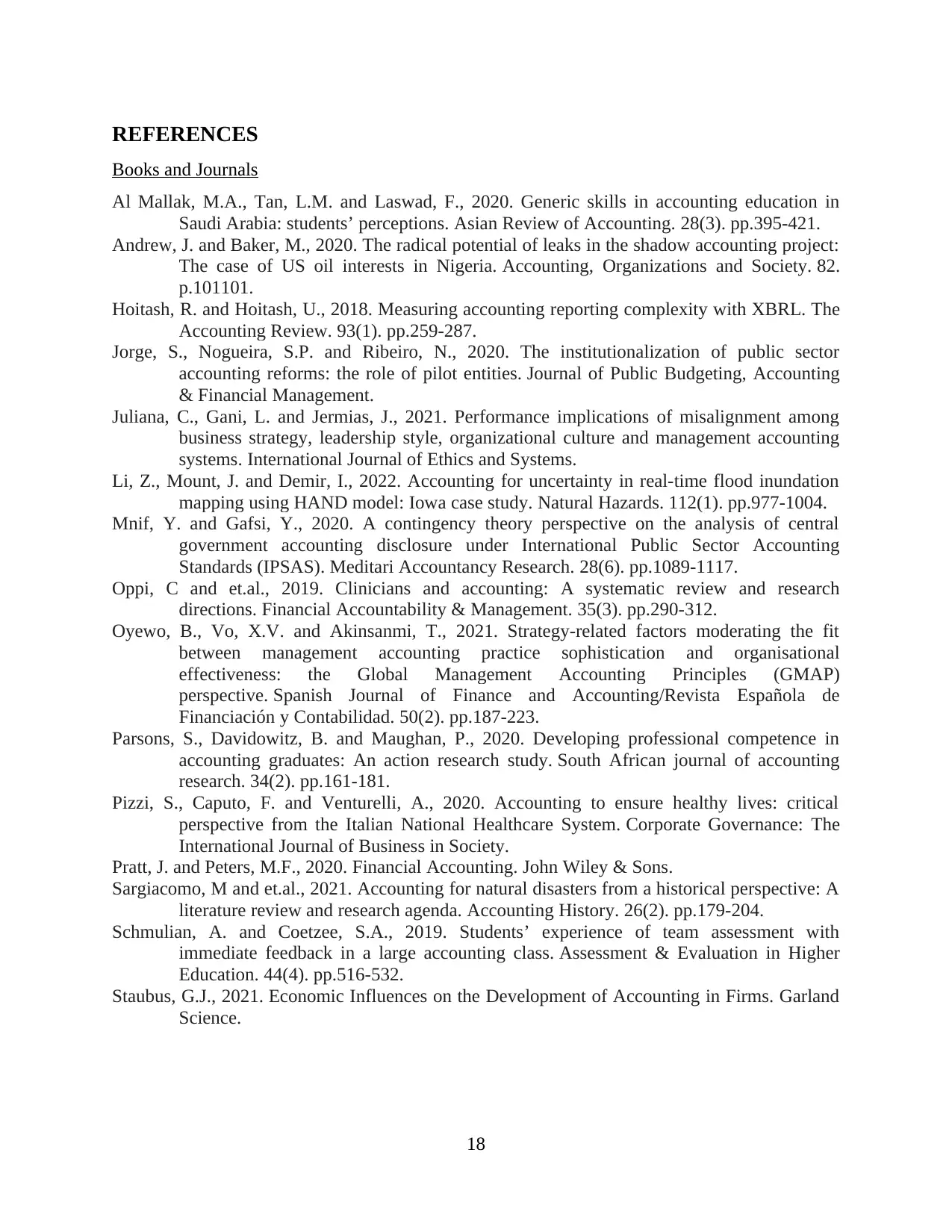
REFERENCES
Books and Journals
Al Mallak, M.A., Tan, L.M. and Laswad, F., 2020. Generic skills in accounting education in
Saudi Arabia: students’ perceptions. Asian Review of Accounting. 28(3). pp.395-421.
Andrew, J. and Baker, M., 2020. The radical potential of leaks in the shadow accounting project:
The case of US oil interests in Nigeria. Accounting, Organizations and Society. 82.
p.101101.
Hoitash, R. and Hoitash, U., 2018. Measuring accounting reporting complexity with XBRL. The
Accounting Review. 93(1). pp.259-287.
Jorge, S., Nogueira, S.P. and Ribeiro, N., 2020. The institutionalization of public sector
accounting reforms: the role of pilot entities. Journal of Public Budgeting, Accounting
& Financial Management.
Juliana, C., Gani, L. and Jermias, J., 2021. Performance implications of misalignment among
business strategy, leadership style, organizational culture and management accounting
systems. International Journal of Ethics and Systems.
Li, Z., Mount, J. and Demir, I., 2022. Accounting for uncertainty in real-time flood inundation
mapping using HAND model: Iowa case study. Natural Hazards. 112(1). pp.977-1004.
Mnif, Y. and Gafsi, Y., 2020. A contingency theory perspective on the analysis of central
government accounting disclosure under International Public Sector Accounting
Standards (IPSAS). Meditari Accountancy Research. 28(6). pp.1089-1117.
Oppi, C and et.al., 2019. Clinicians and accounting: A systematic review and research
directions. Financial Accountability & Management. 35(3). pp.290-312.
Oyewo, B., Vo, X.V. and Akinsanmi, T., 2021. Strategy-related factors moderating the fit
between management accounting practice sophistication and organisational
effectiveness: the Global Management Accounting Principles (GMAP)
perspective. Spanish Journal of Finance and Accounting/Revista Española de
Financiación y Contabilidad. 50(2). pp.187-223.
Parsons, S., Davidowitz, B. and Maughan, P., 2020. Developing professional competence in
accounting graduates: An action research study. South African journal of accounting
research. 34(2). pp.161-181.
Pizzi, S., Caputo, F. and Venturelli, A., 2020. Accounting to ensure healthy lives: critical
perspective from the Italian National Healthcare System. Corporate Governance: The
International Journal of Business in Society.
Pratt, J. and Peters, M.F., 2020. Financial Accounting. John Wiley & Sons.
Sargiacomo, M and et.al., 2021. Accounting for natural disasters from a historical perspective: A
literature review and research agenda. Accounting History. 26(2). pp.179-204.
Schmulian, A. and Coetzee, S.A., 2019. Students’ experience of team assessment with
immediate feedback in a large accounting class. Assessment & Evaluation in Higher
Education. 44(4). pp.516-532.
Staubus, G.J., 2021. Economic Influences on the Development of Accounting in Firms. Garland
Science.
18
Books and Journals
Al Mallak, M.A., Tan, L.M. and Laswad, F., 2020. Generic skills in accounting education in
Saudi Arabia: students’ perceptions. Asian Review of Accounting. 28(3). pp.395-421.
Andrew, J. and Baker, M., 2020. The radical potential of leaks in the shadow accounting project:
The case of US oil interests in Nigeria. Accounting, Organizations and Society. 82.
p.101101.
Hoitash, R. and Hoitash, U., 2018. Measuring accounting reporting complexity with XBRL. The
Accounting Review. 93(1). pp.259-287.
Jorge, S., Nogueira, S.P. and Ribeiro, N., 2020. The institutionalization of public sector
accounting reforms: the role of pilot entities. Journal of Public Budgeting, Accounting
& Financial Management.
Juliana, C., Gani, L. and Jermias, J., 2021. Performance implications of misalignment among
business strategy, leadership style, organizational culture and management accounting
systems. International Journal of Ethics and Systems.
Li, Z., Mount, J. and Demir, I., 2022. Accounting for uncertainty in real-time flood inundation
mapping using HAND model: Iowa case study. Natural Hazards. 112(1). pp.977-1004.
Mnif, Y. and Gafsi, Y., 2020. A contingency theory perspective on the analysis of central
government accounting disclosure under International Public Sector Accounting
Standards (IPSAS). Meditari Accountancy Research. 28(6). pp.1089-1117.
Oppi, C and et.al., 2019. Clinicians and accounting: A systematic review and research
directions. Financial Accountability & Management. 35(3). pp.290-312.
Oyewo, B., Vo, X.V. and Akinsanmi, T., 2021. Strategy-related factors moderating the fit
between management accounting practice sophistication and organisational
effectiveness: the Global Management Accounting Principles (GMAP)
perspective. Spanish Journal of Finance and Accounting/Revista Española de
Financiación y Contabilidad. 50(2). pp.187-223.
Parsons, S., Davidowitz, B. and Maughan, P., 2020. Developing professional competence in
accounting graduates: An action research study. South African journal of accounting
research. 34(2). pp.161-181.
Pizzi, S., Caputo, F. and Venturelli, A., 2020. Accounting to ensure healthy lives: critical
perspective from the Italian National Healthcare System. Corporate Governance: The
International Journal of Business in Society.
Pratt, J. and Peters, M.F., 2020. Financial Accounting. John Wiley & Sons.
Sargiacomo, M and et.al., 2021. Accounting for natural disasters from a historical perspective: A
literature review and research agenda. Accounting History. 26(2). pp.179-204.
Schmulian, A. and Coetzee, S.A., 2019. Students’ experience of team assessment with
immediate feedback in a large accounting class. Assessment & Evaluation in Higher
Education. 44(4). pp.516-532.
Staubus, G.J., 2021. Economic Influences on the Development of Accounting in Firms. Garland
Science.
18
1 out of 20
Related Documents
Your All-in-One AI-Powered Toolkit for Academic Success.
+13062052269
info@desklib.com
Available 24*7 on WhatsApp / Email
![[object Object]](/_next/static/media/star-bottom.7253800d.svg)
Unlock your academic potential
© 2024 | Zucol Services PVT LTD | All rights reserved.


